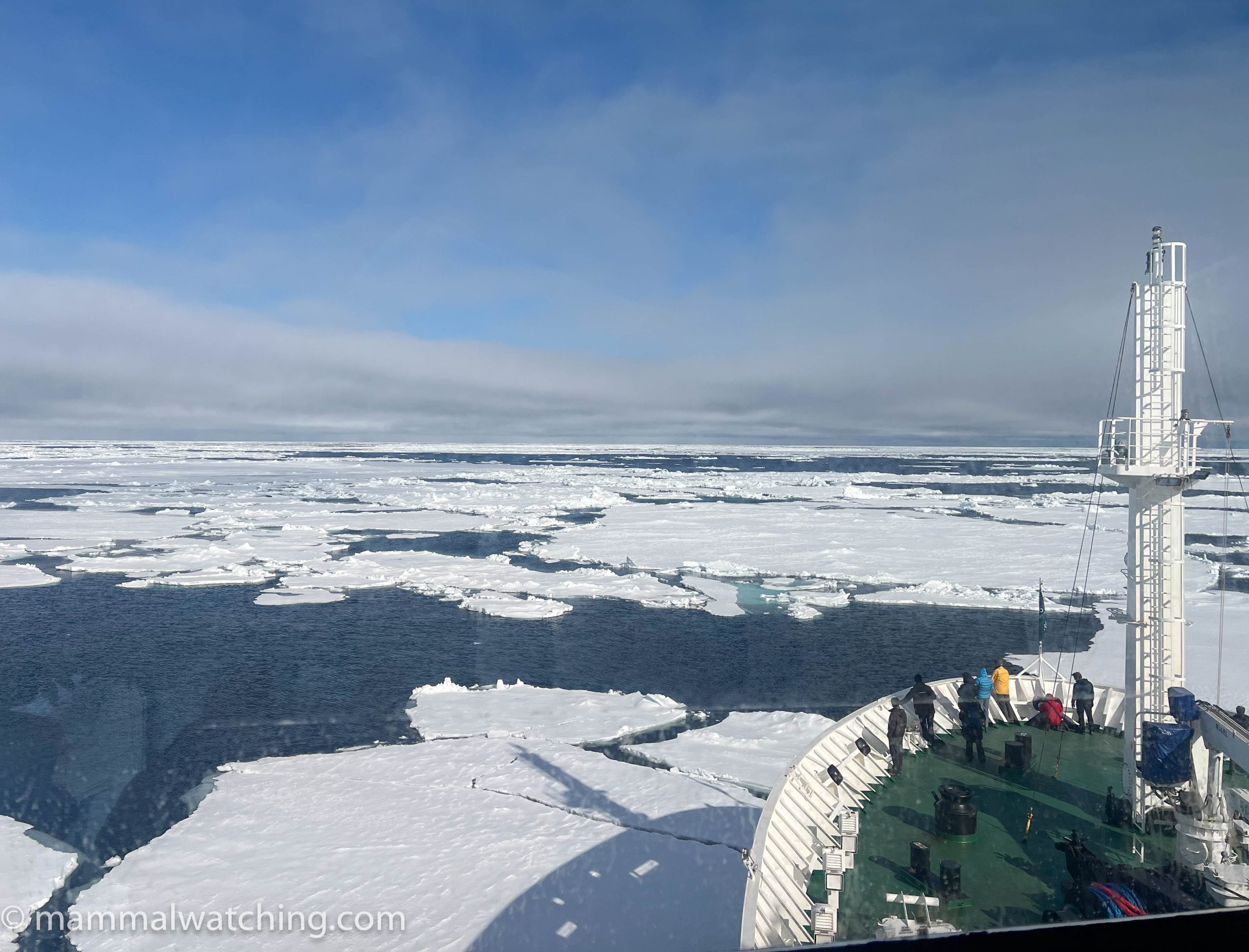
Bowheads & Bears Cruise, Svalbard 2024
I’ve been a tiny bit obsessed with seeing a Bowhead Whale for as long as I can remember and I’m not sure why. Maybe it is because they are the longest-lived mammal on the planet: If you see a Bowhead then you might be looking at an animal that was born before the American Civil War (and if you are reading this in 2026 or later then I am talking about the first one!). It may be because they are a five year old’s caricature of what a whale should look like with that enormous head that can break though 20cm of sea ice. Or maybe it is just that Bowhead Whale is such a romantic name. My motivation may have been unclear but I was certain I had to see one properly.
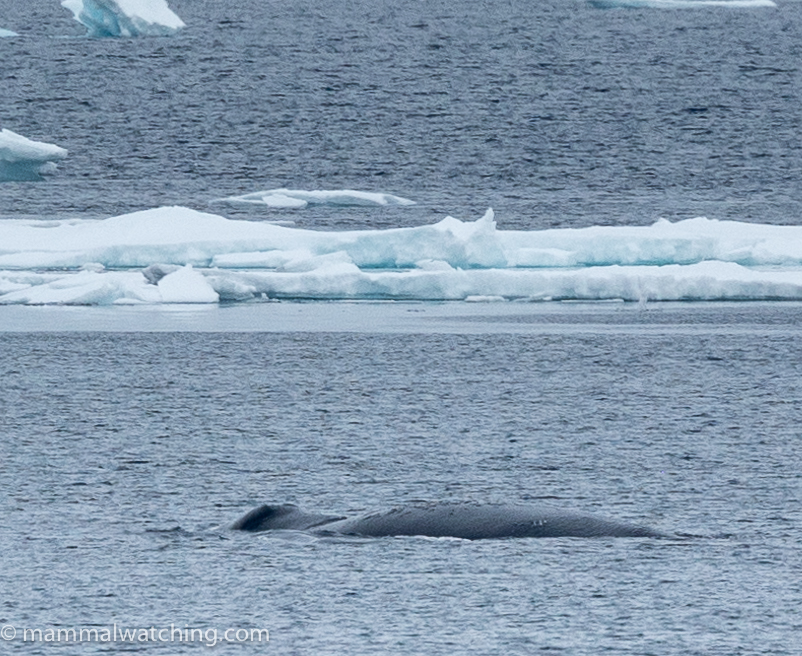
Bowhead Whale (Balaena mysticetus)
But where to go? I’d seen Bowheads as specks on the horizon in Baffin Island in 2006, but they didn’t count. The Shantar Islands in Russia is reputed to be a great place to see them but Russia was off limits in 2024. I could not find much information on how to look for them in Alaska. They migrate past Point Barrow in the Alaskan spring but I don’t know of any whale watching trips up there. Greenland is another option and Morten Kure Kattenhøj recommended trying Disco Bay in the spring. I was starting to looking into that when Jonathan Ben Simon emailed me in 2022 to say he had seen Bowhead Whales, along with Hooded and Harp Seals, on a cruise to the pack ice north of Spitsbergen. It took me about 20 minutes to start planning a trip. And for information – I didn’t know myself – Svalbard is the name of the entire archipelago, while Spitsbergen is the name of the main island. I will probably use them interchangeably but you get what I mean.
I am not a huge fan of cruise ships. Or rather, I am not a huge fan of cruises, but they are the only affordable option to travel to many places. The first – and only other – cruise I had taken was also to Svalbard, back in 2006. As you can see from my report I complained a lot.
This second cruise was better in many ways, largely because I travelled with a group of mammalwatchers who helped spot the wildlife and also provided some voting power when we were lobbying for more mammalwatching-friendly activities on board. They came with the added bonus of being fun, interesting travel companions. Ten of us of eventually signed up for this trip, including names that I knew from the website but had never met: Jonas Livet & Ruta Vaicekauskaite from France; Jean Dille, Jean-Philippe Ferette & Kristin van Gaever from Belgium; as well as old friends Nik Sekhran and Chrissie Lippai and others.
We met in Longyearbyen in June 2024.
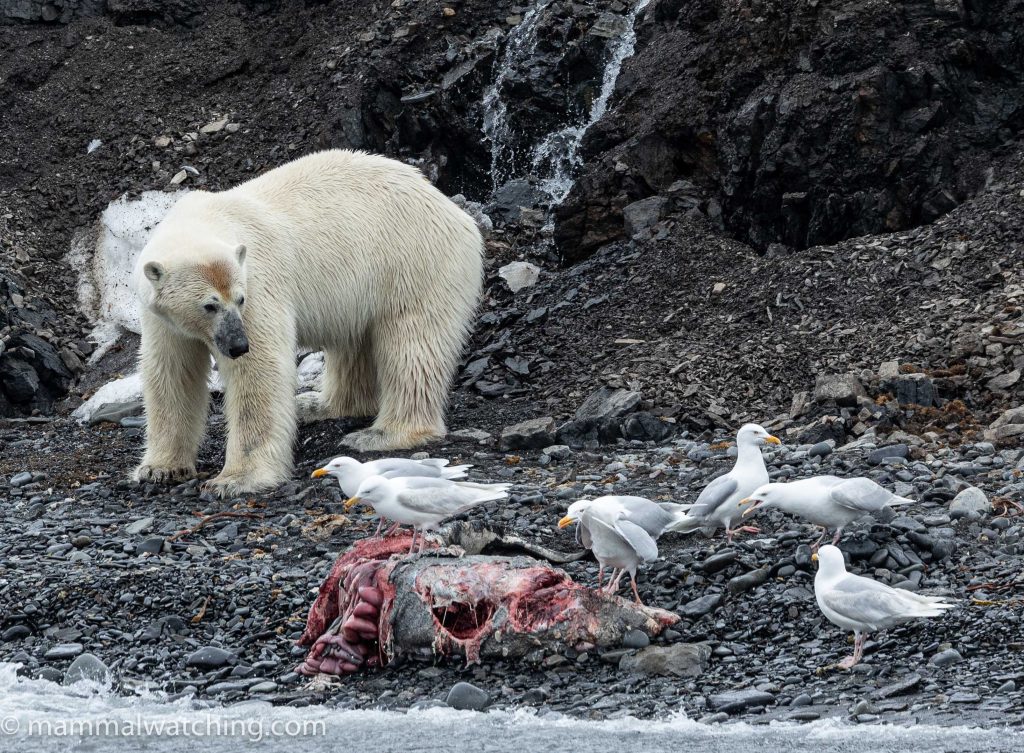
Polar Bear (Ursus maritimus)
Longyearbyen
Longyearbyen was larger than I remembered. There are now plenty of gift shops and restaurants catering to the thousands of cruise ship passengers who flood through the town some days. Svalbard Reindeer (a very small subspecies) are, along with tourists, everywhere. If you want to look for other wildlife around town you will need to book a tour as visitors are forbidden from wandering out of town because of the bears.
A variety of tours are advertised around Longyearbyen. Some of them go in search of dolphins and bears. Some of our group took a trip to look for Arctic Foxes during their first evening in Longyearbyen. They saw several foxes out of town after 11pm, as well as a Walrus or two and some ‘good’ birds. Some of us stayed in Longyearbyen and went in search of beer. We were equally successful. I stayed at the very comfortable and cosy Basecamp Hotel.
The following afternoon we boarded the ship – which was docked at the coal pier in Longyearbyen – and saw our first Walruses of the week. Three were hauled out on the beach directly in front of the ship.
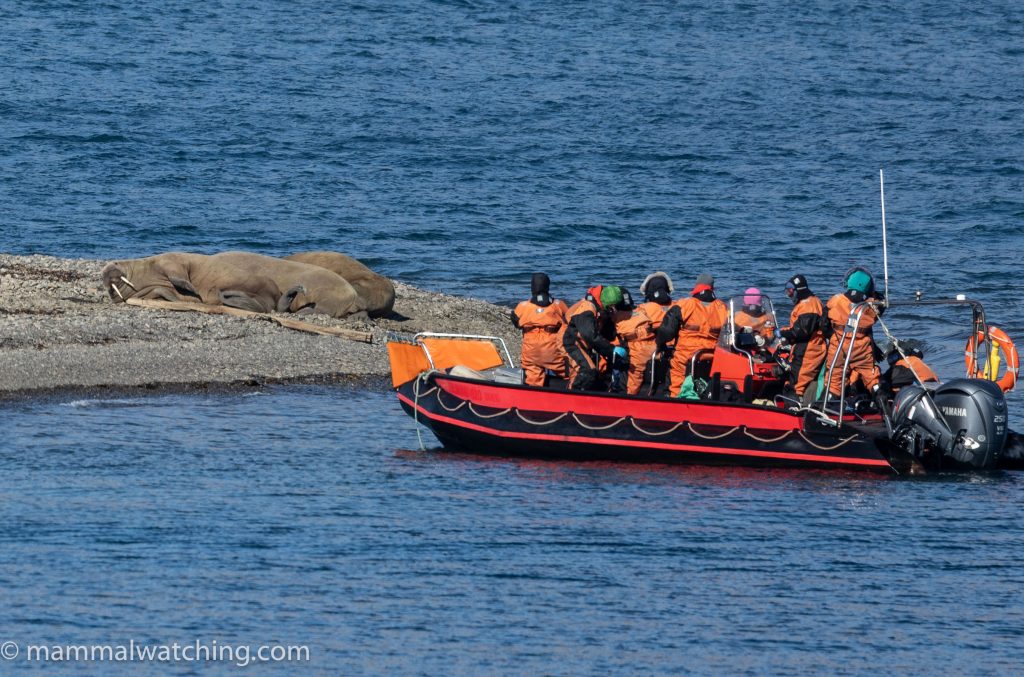
Walrus (Odobenus rosmarus) at Longyearbyen
I run through a brief day by day itinerary below and then get into the different mammals. But first a few thoughts about cruises and this cruise in particular.
Cruising for Mammals
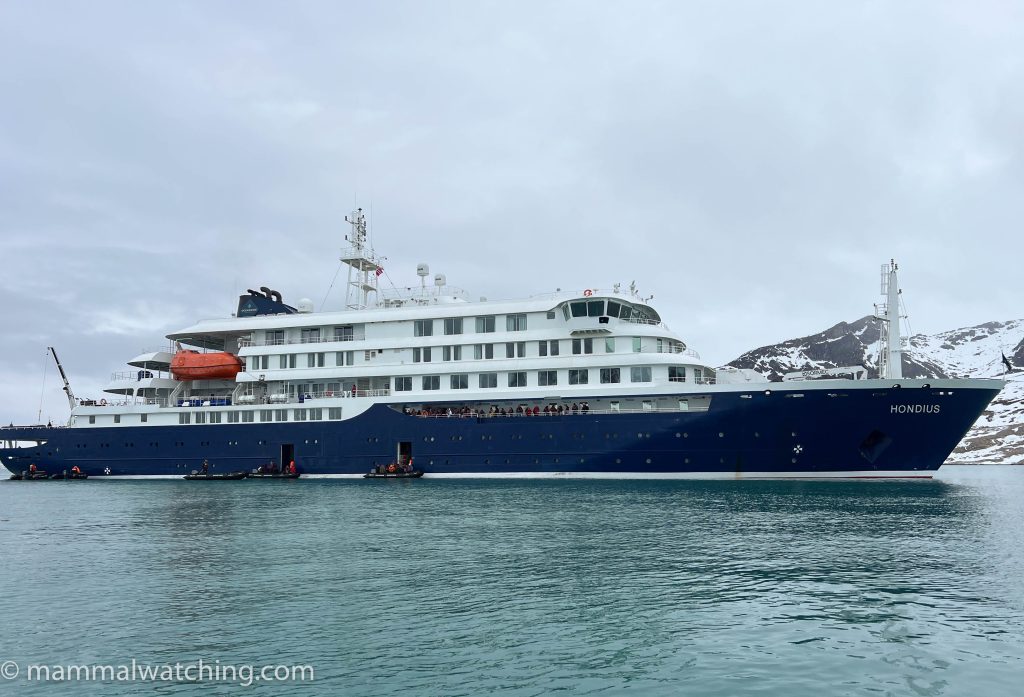
M.V. Hondius
Like many of the people who use this website I am used only to independent travel, where I make the decisions and rely on help from expert private guides. A cruise is very different and takes some getting used to. Two things will help with the transition I think. First, manage your expectations and accept that a large cruise is likely the only affordable way for you to travel to where you are going. Second, travel with a group of like minded people (i.e. mammalwatchers). Here are some more details.
The Ship
We travelled with Oceanwide Expeditions on the M.V. Hondius, a purpose built polar cruise ship that carries170 passengers and 50 crew. The ship was more luxurious than I had imagined. I shared a twin porthole cabin with Jean Dille on deck 3: we were pretty much at the bottom of the cabin pecking order. But we had our own bathroom and a comfortable cabin, though – unlike those on decks 7 and 8 – we could not lounge in armchairs and look for whales through panoramic windows.
The food was excellent, and came in huge quantities three times a day. The bar was also well stocked and very reasonably priced (no need to stock up on booze before you get arrive). The Hondius carried 16 zodiacs so all the passengers could leave the ship at the same time. There were a ton of rules, safety briefings and queuing at various points of the week but the crew were a friendly group of people who tried to make it fun.
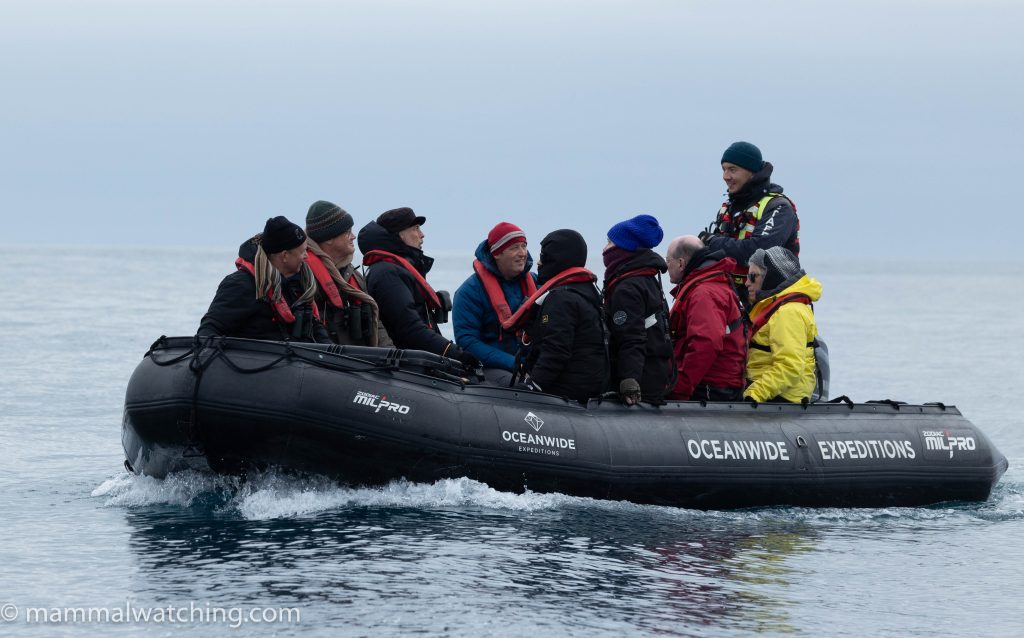
Zodiac trip
The Hondius is well set up for wildlife watching. The view from the bridge, often open to everyone, was spectacular (plus it was warm ), though if you were serious about taking pictures you needed to be outside, either on the top deck (8) or the main deck (5). I circled between the bridge and those two decks depending on how cold it was and which people were watching from each area. We had pretty flat seas for the whole trip so it’s hard to judge how stable the ship would be in rougher weather but on the couple of occasions we were in a bit of a swell it was hard to notice any movement on board the ship..
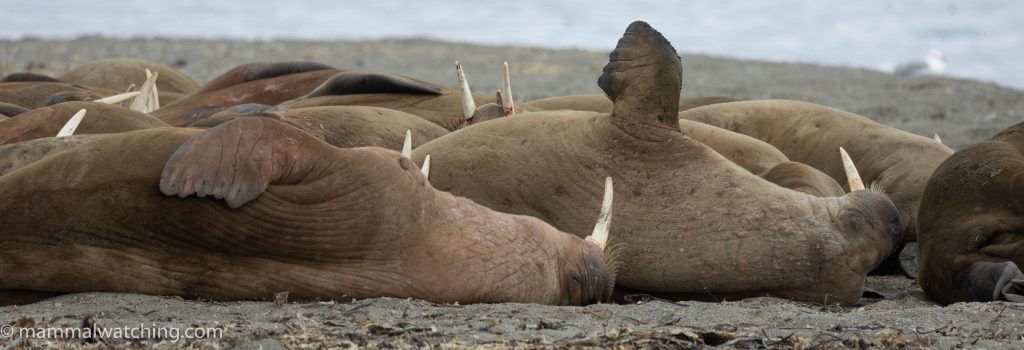
Walrus (Odobenus rosmarus)
The Guides
It is tempting to imagine that the ship’s guides will spot most of the animals. They didn’t. The guides on the ship, who all have different areas of expertise, are primarily there to look after ‘normal’ passengers and keep them safe. They drive the zodiacs, give talks and answer each and every inane question while keeping a happy smile on their face. Which must be tough. For instance when we were looking at two polar bears with numbers painted onto their fur someone in our zodiac asked “Why do they have numbers on their fur? Is it for research?” … “No”, I muttered to Chrissie, “they are in a football team”.
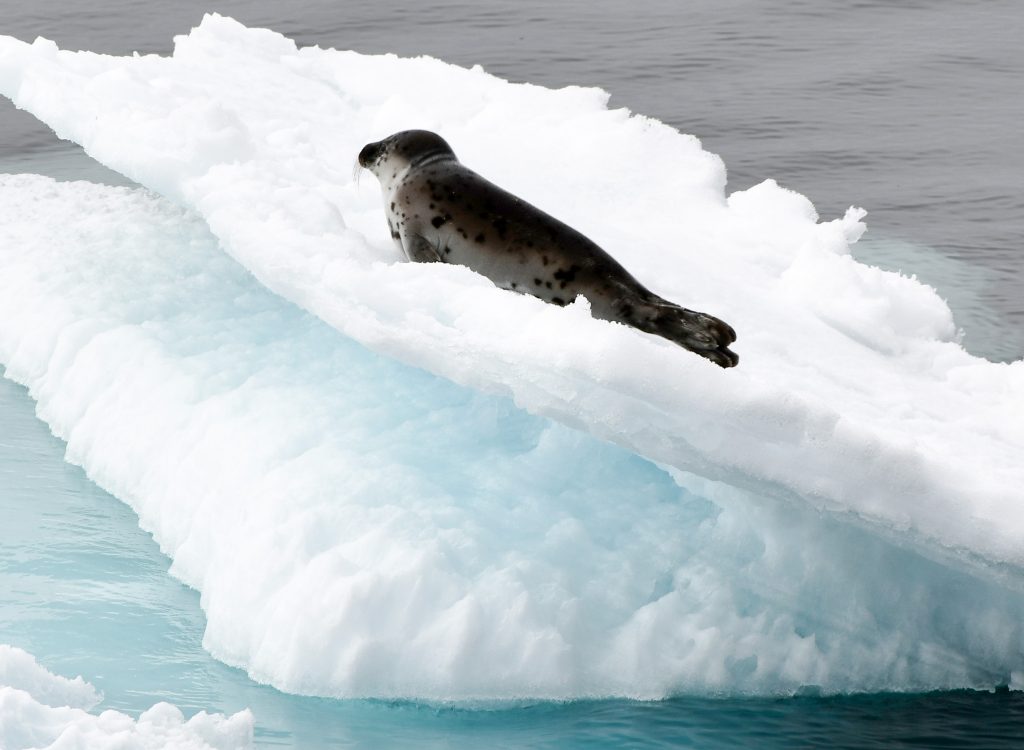
Hooded Seal (Cystophora cristata). Photo Jonas Livet
The guides did keep a look out for wildlife, though their main focus is on finding a bear or animals that will entertain the whole ship. If the seem something that is interesting, close and likely to stick around for more than 3 minutes they would make an announcement over the PA system. They deliberately chose not to mention some of the animals they saw whne they felt they might disappear before the passengers could get onto deck to look for them.
When we were sailing through the pack ice there were usually several guides searching from the bridge. It was useful to be up there with them, eavesdropping on their whispered conversations. But still it was the passengers – our mammalwatching group and the WildWings group mainly – who spotted just 90% of the best mammals. Chrissie, on the bridge, spotted the first Bowhead Whale. I spotted the next pair, again from the bridge, at about the same time that Chris from WildWings on deck 8 also spotted them (at that moment the guides were taking a group photo of themselves).
It is probably unreasonable to expect the ship’s guides to give the kind of help that you might get on a personal mammalwatching trip. So for a happier trip I suggest you manage your expectations and recognize you will need to find the animals yourself. This is one very obvious advantage of taking a cruise with other mammalers.
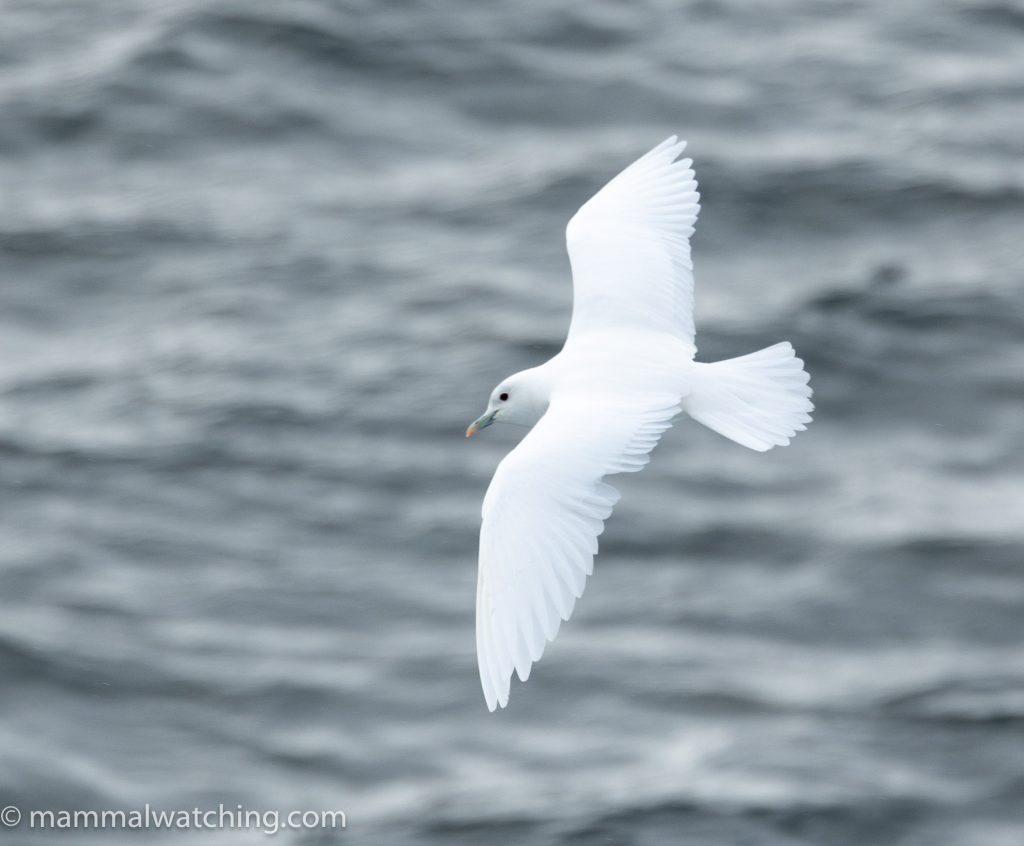
Ivory Gull
That said I had expected the guides to be a bit more knowledgeable about the wildlife, especially the seals. Just about every seal we saw was confidently identified by one or other of the guides as either Ringed or Bearded. Yet our photos showed we saw several Harp and Hooded Seals. Indeed some of the guides claimed never to have seen Harp or Hooded Seals over the course of many trips and probably did not even know what they looked like.
We didn’t see many as many seals as I had imagined on the ice floes, and most of those we saw were distant, But my hunch is that Harp and Hooded Seals were as – maybe more – common than Bearded or Ringed Seals out in the pack ice. While Ringed, Bearded, and Harbour Seals were more common around the shoreline. Seals can be tough to identify from a distance so some of the guides at times wouldt have done better to have said they didn’t know which species we were looking at.
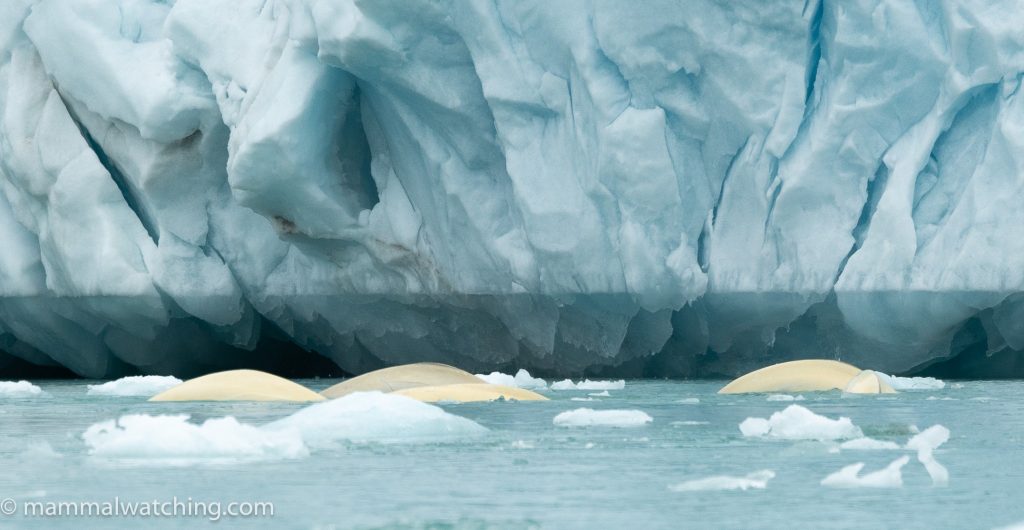
Beluga (Delphinapterus leucas)
Activities
On most days the ship offered a morning and afternoon excursion. This might be a zodiac ride into a fjord or a landing accompanied by a guided hike or a ‘perimeter’ walk (for perimeter walk think a dog park for passengers: you are free to frolic off-leash inside a protected area set up by the armed guides).
So you have little freedom as a passenger but there it is totally understandable. The guides need to keep the guests on a tight leash when Polar Bears are wandering around. But that doesn’t make it any easier to get used to when you are accustomed to travel with freedom in what you choose to do each day and how you choose to do it.
Landings are not very good for mammalwatching, unless you want to see Arctic Foxes. An added advantage of travelling in a group is that there were enough of us to fill our own zodiac which we could commandeer for a wildlife cruise instead of taking an organized hike. We only did this once but were treated to fabulous looks at a pair of Minke Whales close to the zodiac.
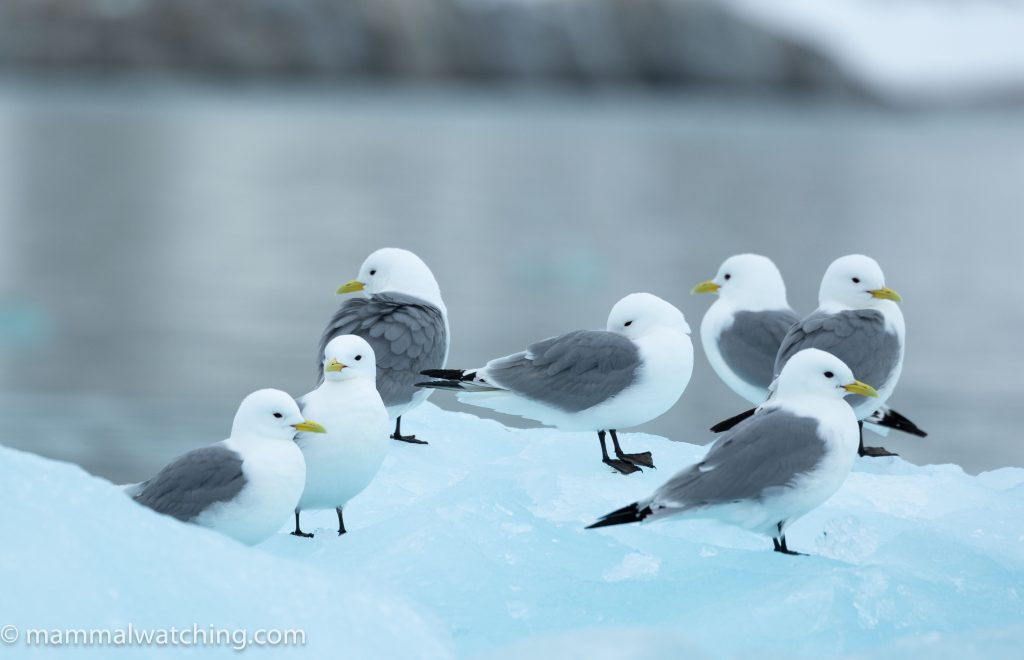
Communication
My biggest gripe is with the lack of information we were given about what was happening and when. It felt that passengers with questions were often treated like kids.
“Where are we going tomorrow?”
“You will have to wait and see”.
This was frustrating. Worse it contributed to a bigger problem on this particular cruise.
The reason that I -,and many of the hardcore wildlife people on board – had booked this particular trip was that it was a bit different to the standard Svalbard cruises. This would be a special Bowhead Whale expedition that would sail northwest into the pack ice for three days in search of the whales along with Hooded and Harp Seals and more. Not long into the trip it felt like something was off. We were all excited about what to expect in the pack ice. But when we chatted with some of guides they hinted that we would only spend a day in the ice, though comments like that were always followed up with “but the cruise director will let us know the plans at the end of each day”.
On the third day we got into the ice, on schedule. It was fabulous. But that evening we left the ice and the expedition leader announced we were returning to the Svalbard coast for the rest of the trip. This was not the plan as we had understood it.
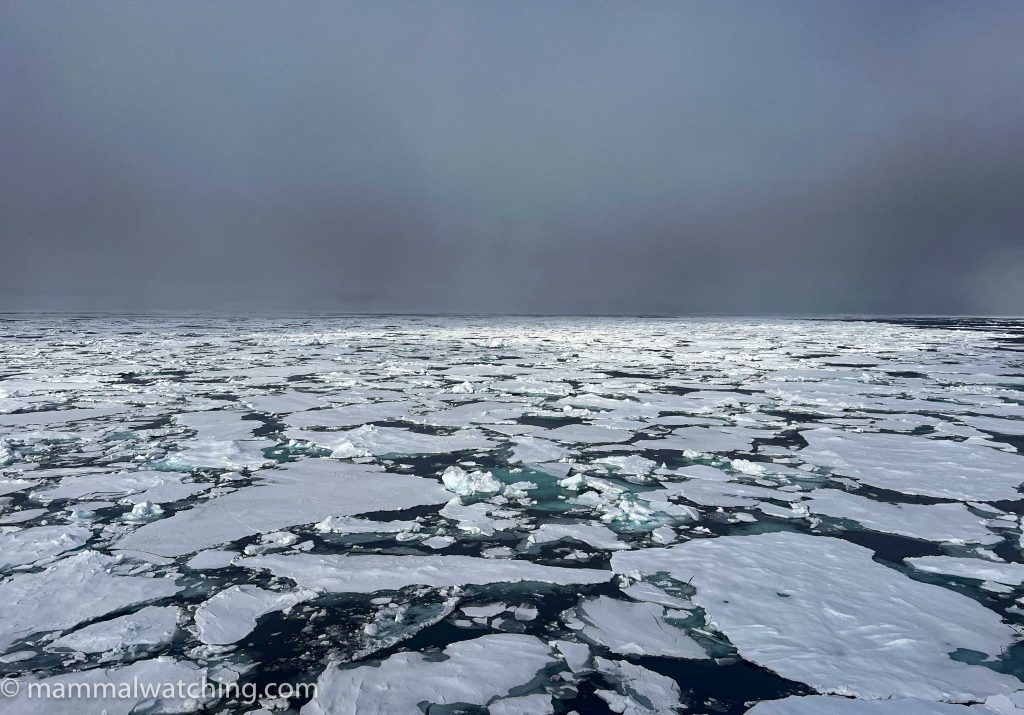
A few of us – including Chris from the WildWing group who has a lot of experience organising polar voyages – met the expedition leader to find out what was happening. He,and his team were skeptical that we should be sailing further into the pack ice. No one had told the crew that we were supposed to be following a non-standard itinerary. The ship was following the route that had been uploaded into the Arctic Expedition Cruise Operators calendar. A route that had been shared with other cruise ships around Svalbard.
Fortunately their skepticism was turned down several notches after Jonas produced a print out of the information on our cruise that he had lifted from the Oceanwide website (for his very useful pre-tour manual). Now the crew were convinced to take us more seriously and promised to send a message to the Oceanwide office. A few hours later we stopped sailing towards Svalbard and changed course. We seemed to be sailing back towards the ice. Problem solved.
Or so we thought. The next morning we woke up to find we had changed direction again in the night and were next to the Svalbard coast. Later that morning the crew received more instructions from head office and told us we would be returning to the ice the next day. They didn’t explain what had gone wrong but we did our best to enjoy our time on the ice without dwelling too much on what might have been.
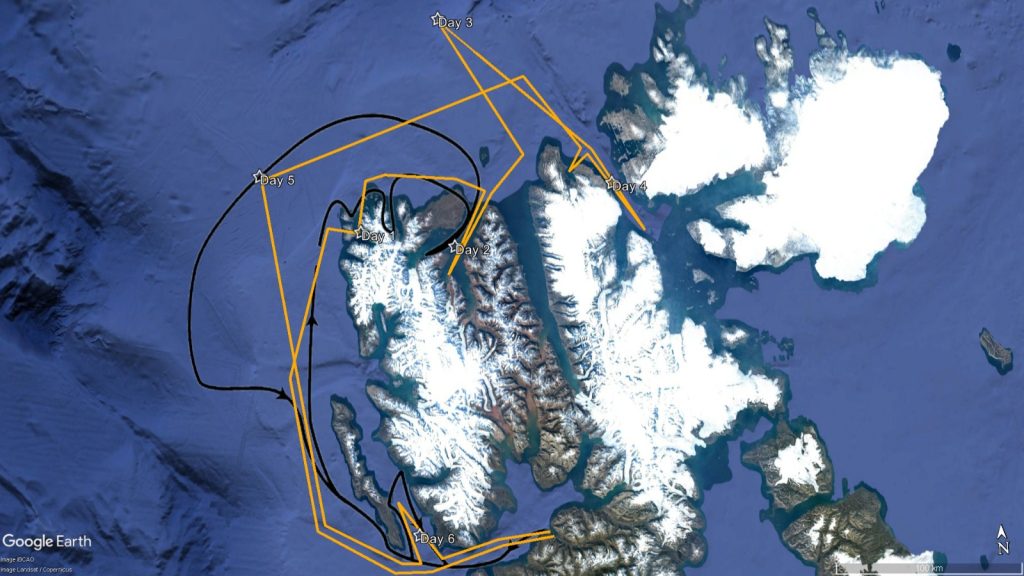
Our route in gold, versus the advertised route in black. From Jonas Livet
In the end, the promised “up to three days in the pack ice” amounted to about 20 hours. The graphic above ,courtesy of Jonas and his GPS, shows the approximate route we took in gold versus where we thought we would head (though the GPS didn’t always work so it is only approximate). I may have seen all the species I wanted to see, but the northwest section – that was bounded by our route and the official route and that we didn’t get into – might have been the best area for the key species. With more time on the ice – which was by far the most interesting bit of the trip – I suspect we would have had better views of the Bowheads, Harp and Hooded Seals. To be fair to Oceanwide they accepted, more or less, that they messed up. And they were able to reclaim some of the lost time in the ice after realising what had happened. But it should not have happened and with better communication it might not have. Maybe the main takeaway is – if you are taking a trip that has a non-standard itinerary – to make sure you have an explicit conversation with the expedition team when you board the boat to check that they are on the same page. I suspect this is not the first time this has happened.
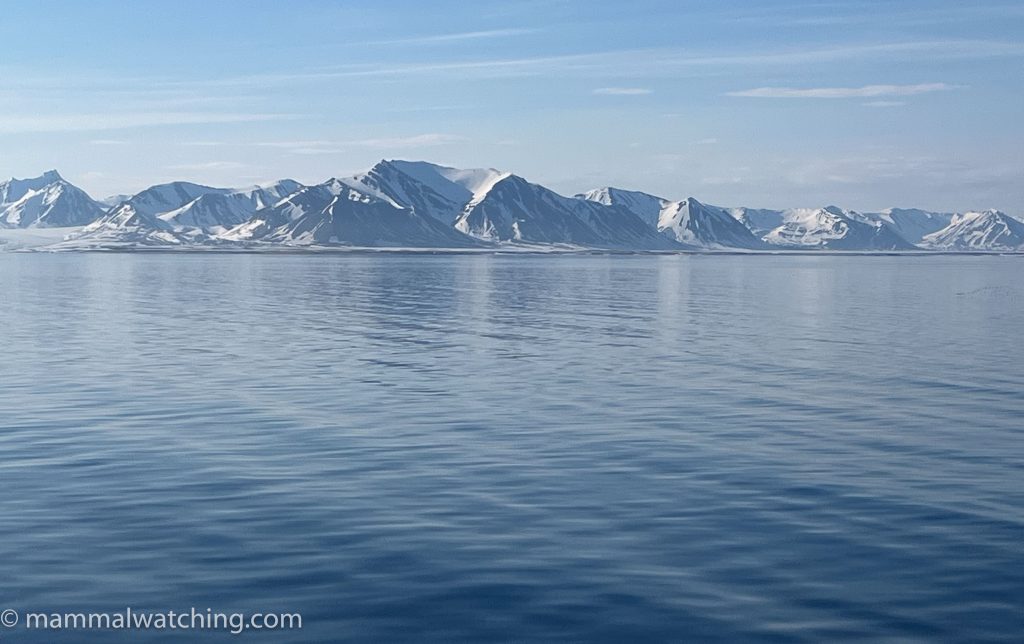
West Coast of Svalbard
In the end our itinerary was as follows.
Day 1: Longyearbyen and heading north. We left about 6pm and headed north up Svalbard’s west coast in great conditions. I didn’t see any mammals other than Walrus in front of the pier in Longyearbyen.
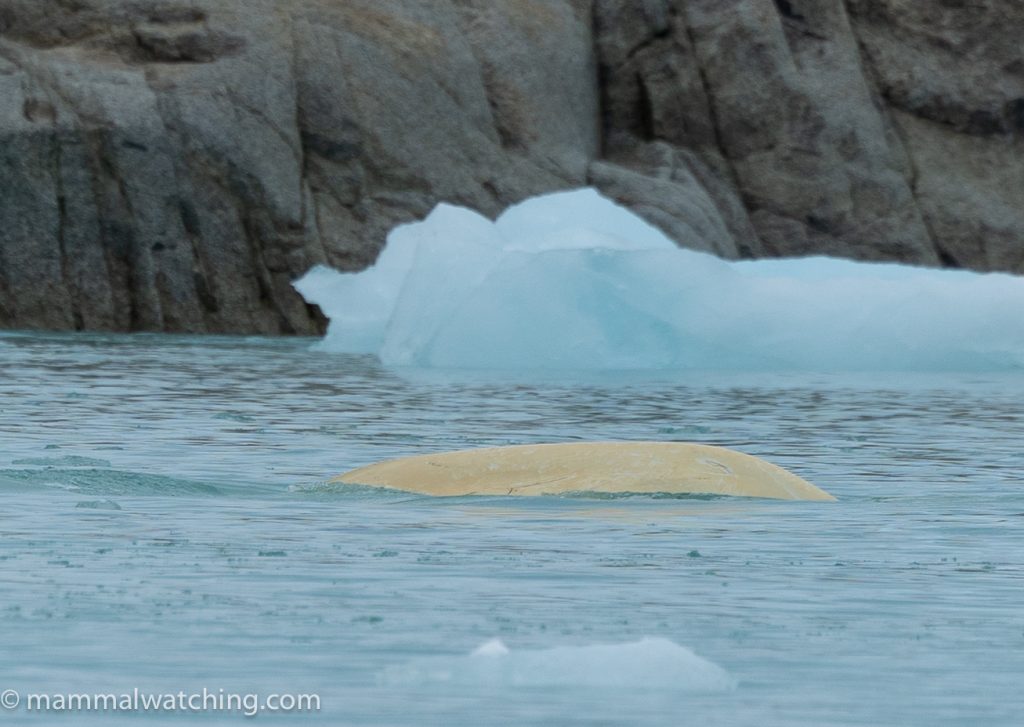
Beluga (Delphinapterus leucas)
Day 2: Northwest Spitsbergen. We spent the day exploring fjords on the northwest of the island and took two zodiac trips. The highlights of which were a pod of 10+ Beluga feeding right intfront of a glacier. We saw a Harbour Seal in the same area and a few Walrus hauled out on the beach. A distant black lump on floating ice in front of a glacier appeared to be a seal, possibly a Ringed Seal, but was too far away to identify with certainty.
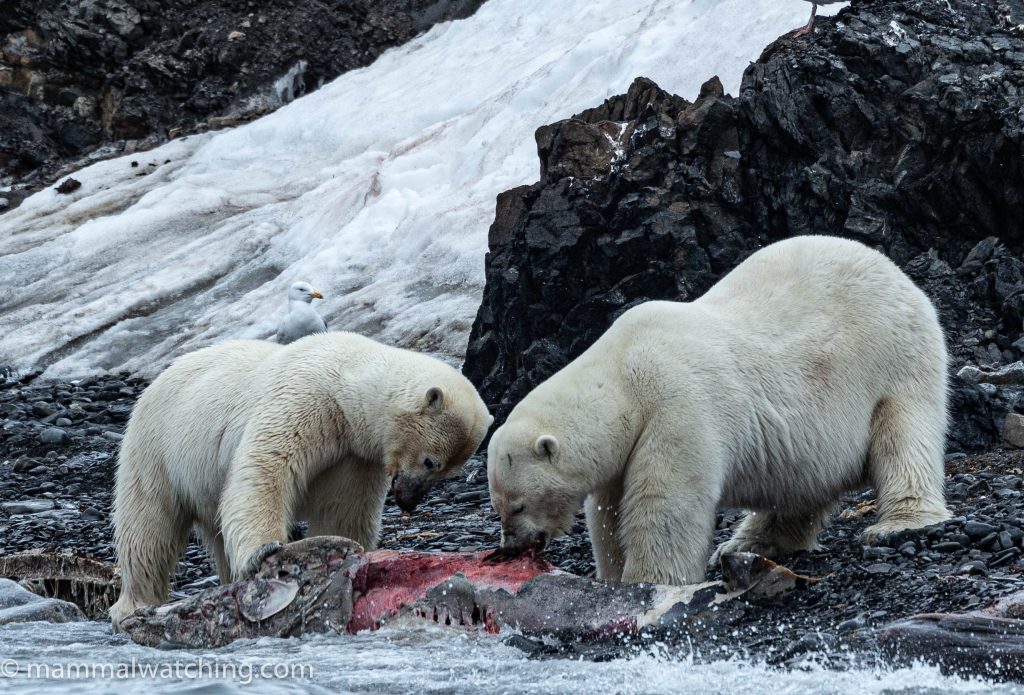
Polar Bear (Ursus maritimus)
Day 3: Northwest Spitsbergen. We spent the day exploring more fjords in the northwest. The highlight was a close encounter from the zodiacs with two Polar Bears feeding on a White-beaked Dolphin carcass – one of several carcasses in various states of decomposition. I learned later that a pod of White-beaked Dolphins had died here trapped in the ice.
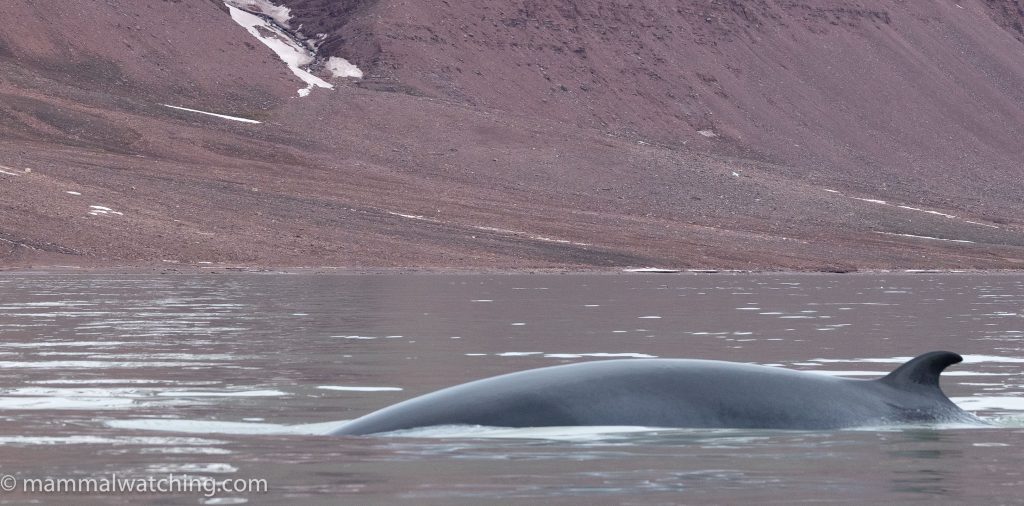
Common Minke Whale (Balaenoptera acutorostrata)
Just before lunch I spotted a Minke Whale that breached several times and which the Hondius followed for 20 minutes. In the afternoon we were scheduled to go ashore for a guided hike but our group got permission to stay on a zodiac and take a drive to look for mammals. We were rewarded by a close encounter with two Minke Whales.
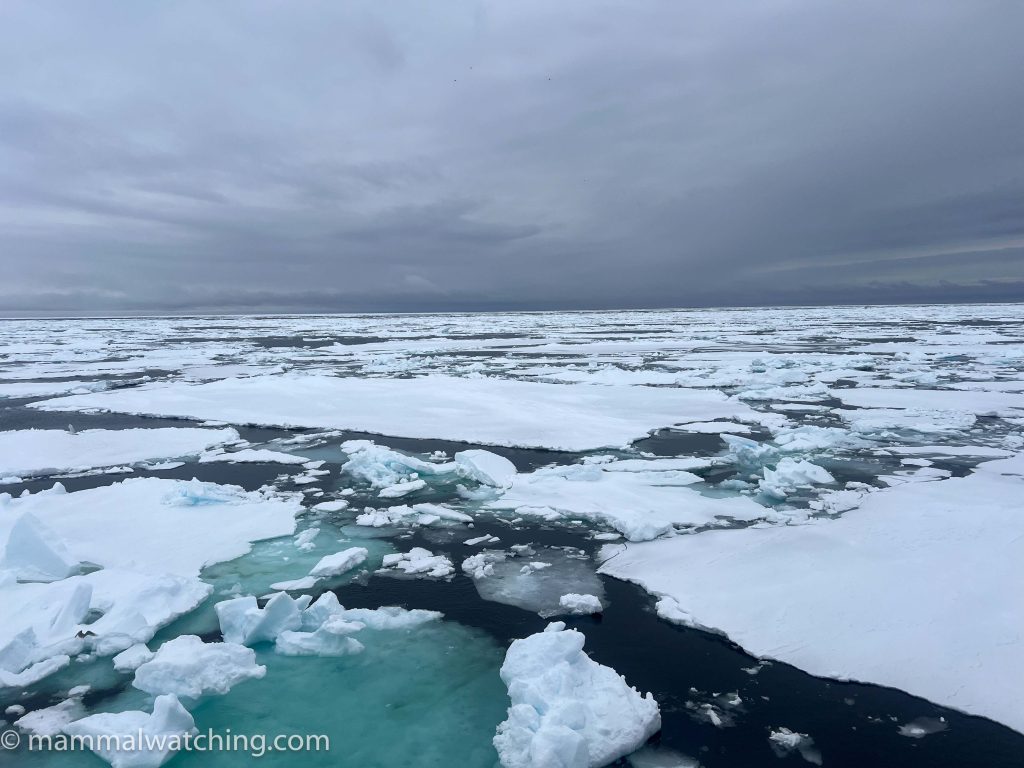
Pack ice
Day 4: Sea Ice to the northwest of Spitsbergen. I was up at 5am, excited to start scanning as we moved along the edge of the sea ice. We began seeing our first seals – mainly Bearded and Ringed Seals – when people woke up and we moved into the ice proper. The guides on the bridge spotted a distant Bowhead Whale just before lunch, and minutes later saw an equally distant bear sleeping on the ice. We could not relocate the whale after 30 minutes and sailed closer to the bear. After lunch Chrissie spotted another Bowhead. This one stuck around and the entire boat had prolonged, but distant, views of it swimming though the ice floe. Magical! Just look at that massive head and blowhole.
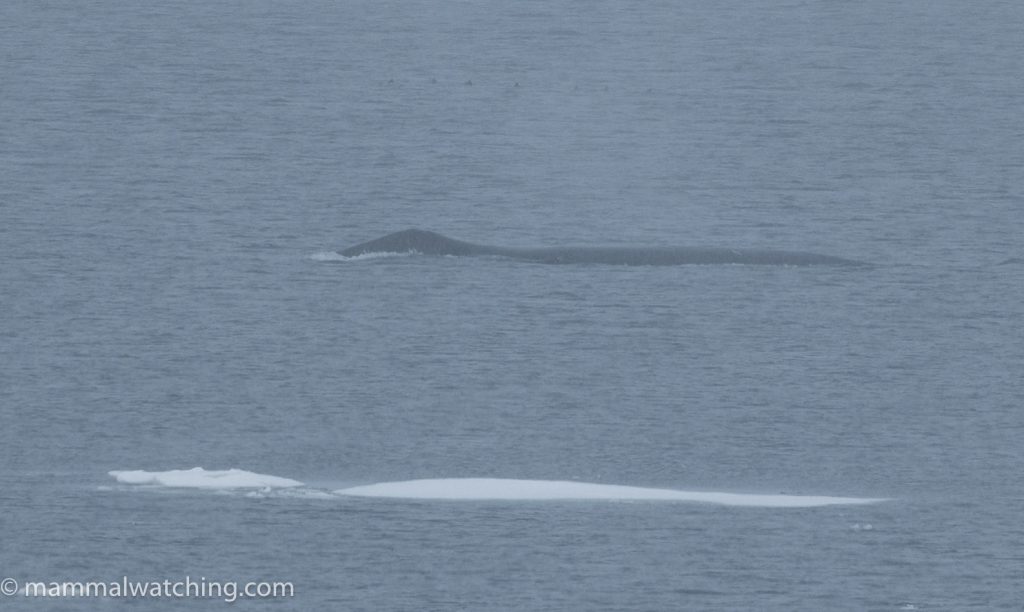
Bowhead Whale (Balaena mysticetus)
During the afternoon we saw several seals including an obliging Bearded Seal, and our first Harp Seals including a raft of 20 or more huddled together in the open water as we were leaving the ice.
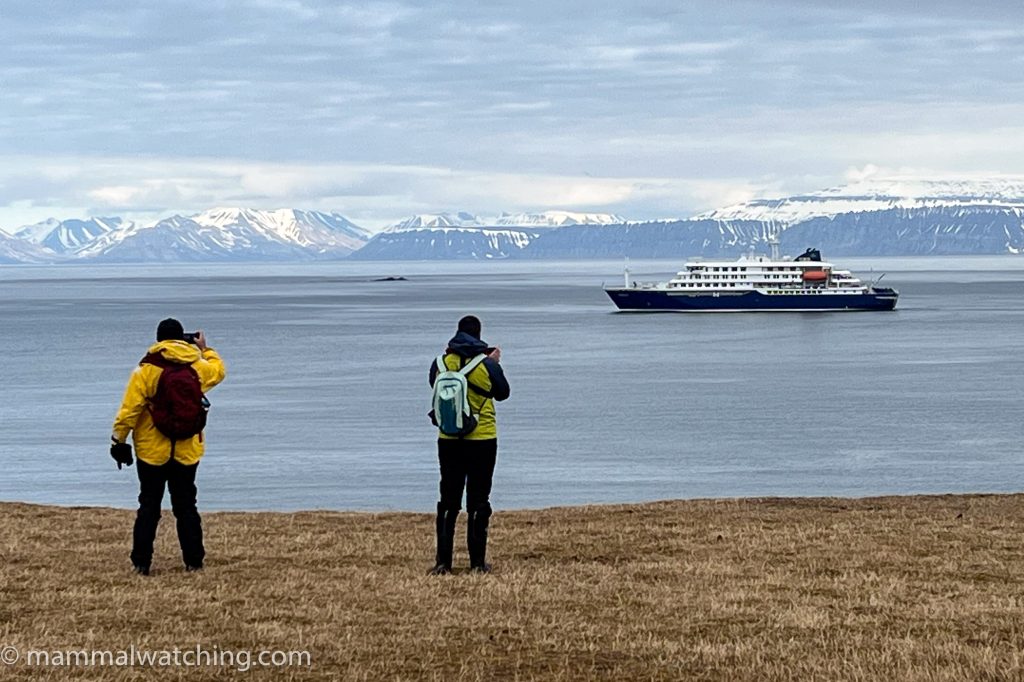
Day 5: Northwest Spitsbergen. We spent the day back in and around the fjords of northwest Spitsbergen (though we ought to have been on the ice – see above). The sea was too rough for a morning activity. In the afternoon most people went ashore and some of them saw an Arctic Fox. I stayed on the ship.
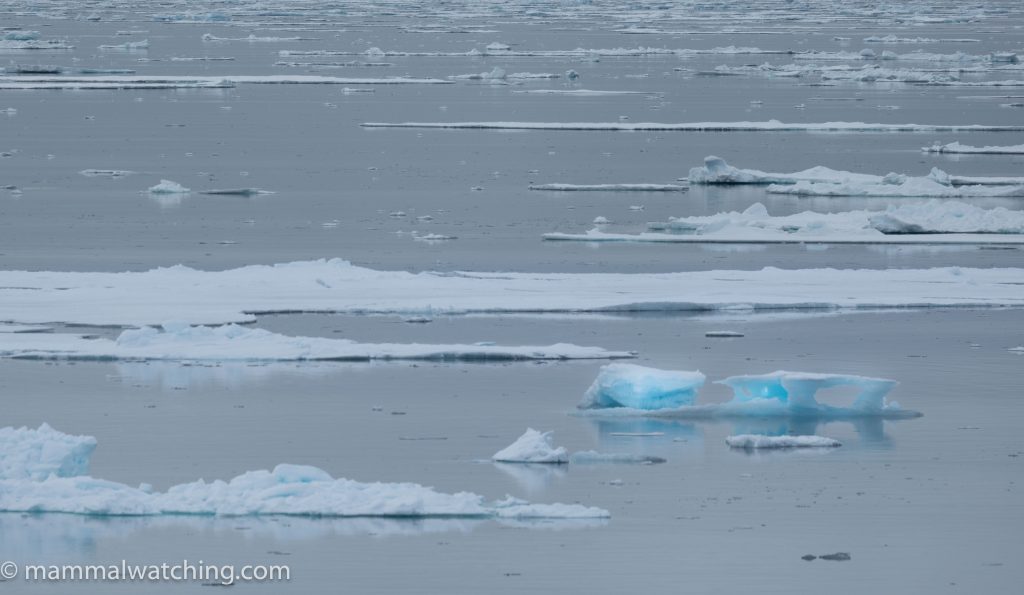
Day 6: Back to the sea ice. The crew realised that they were following the wrong itinerary and we returned to the ice for another magical day picking – and pushing – a path through sheets of ice. We saw more seals, including our first Hooded Seals. I didn’t see any males but some of Chris Collins’s WildWings group spotted a distant male in the water.
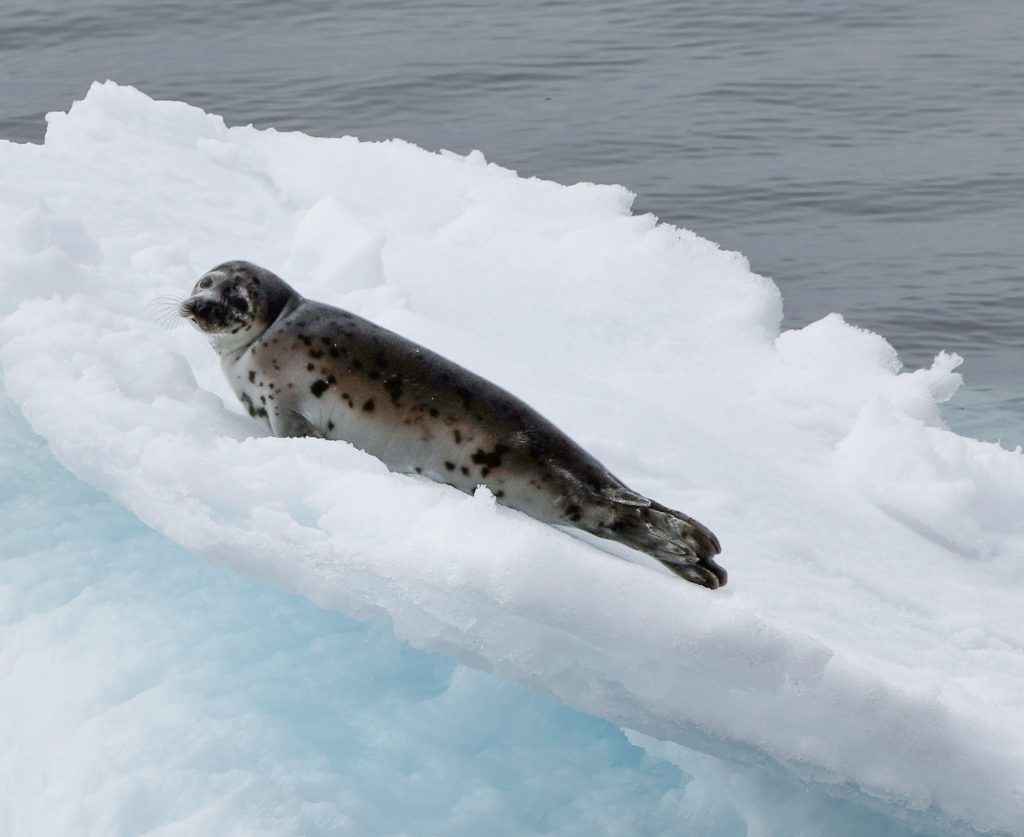
Hooded Seal (Cystophora cristata)
An Arctic Fox adrift on a large piece of ice some 40 miles off shore gave the dog lovers cause for concern. And in the late afternoon I spotted a mother and calf Bowhead swimming though the ice – apparently surface feeding – that gave prolonged views.
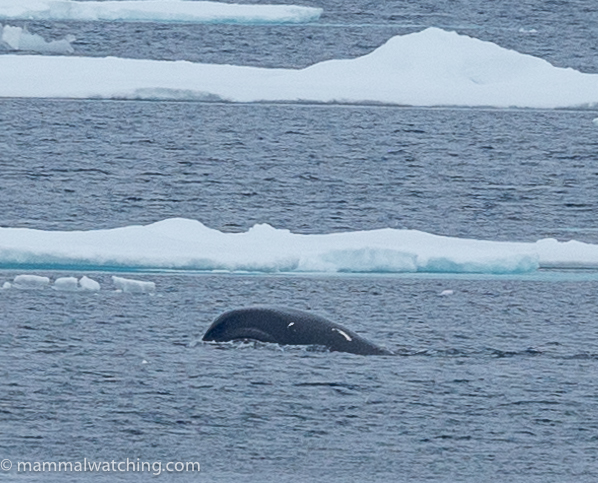
Bowhead Whale (Balaena mysticetus)
We were sad to leave the ice at about 7pm to start heading south.
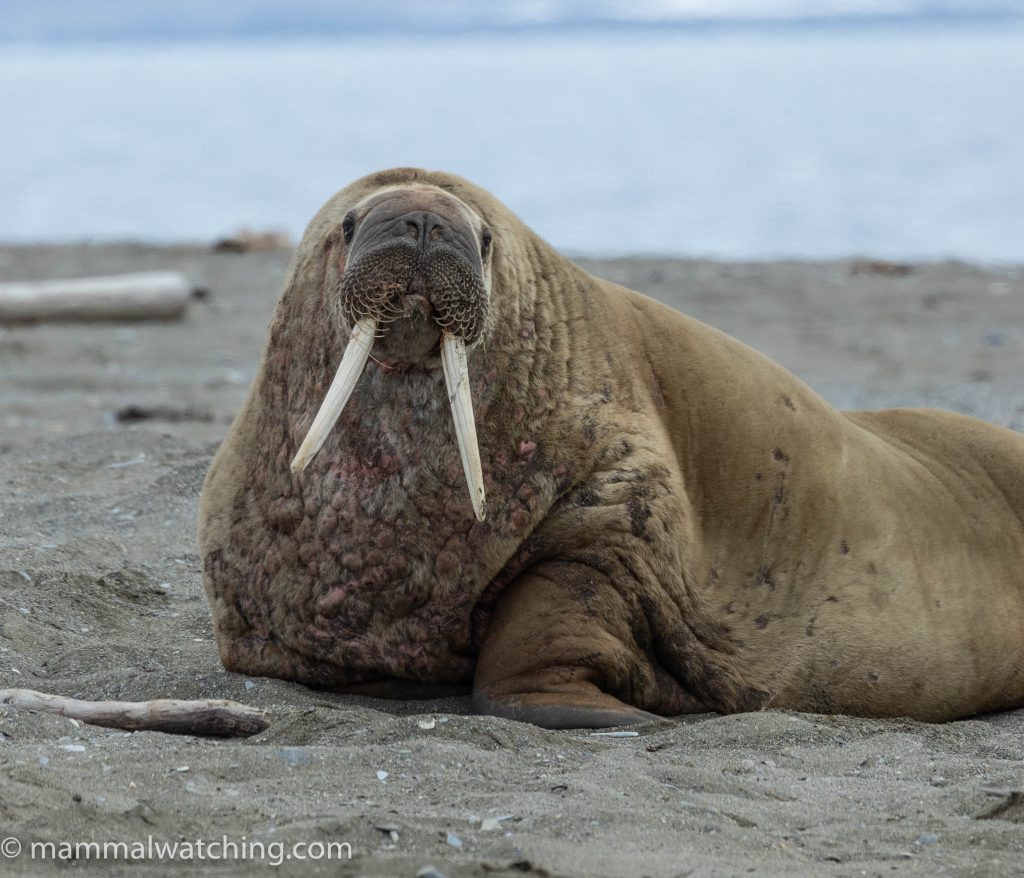
Walrus (Odobenus rosmarus)
Day 7: Cruising back to Longyearbyen. We went ashore at a reliable Walrus haulout in the morning. Twenty or more males were on the beach with Reindeer in the distance. Very photogenic. In the afternoon we went ashore for a perimeter walk. Some people went for a swim. I can’t even ….
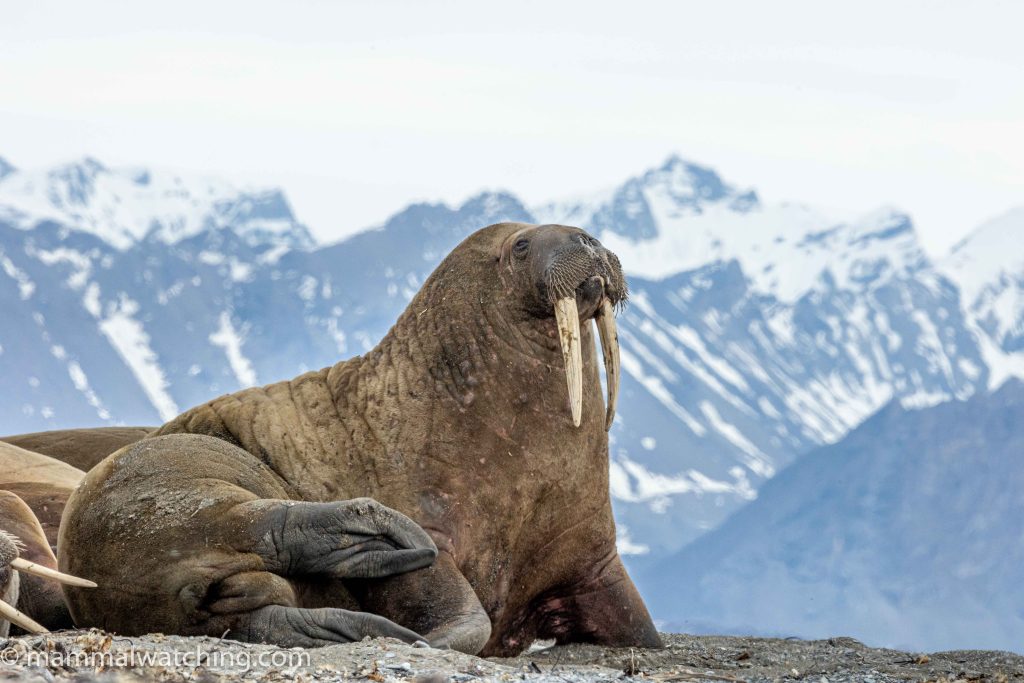
Walrus (Odobenus rosmarus)
Sailing back to Longyearbyen that evening we had at least four Minke Whales in a pod actively feeding around the boat.
The official Oceanwide log is here with more information.
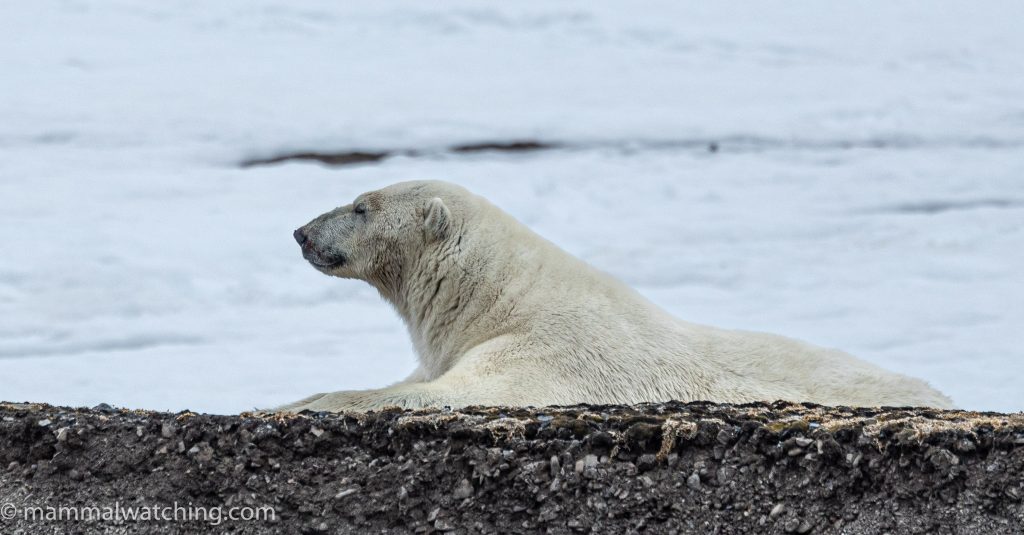
Polar Bear (Ursus maritimus)
The Mammals
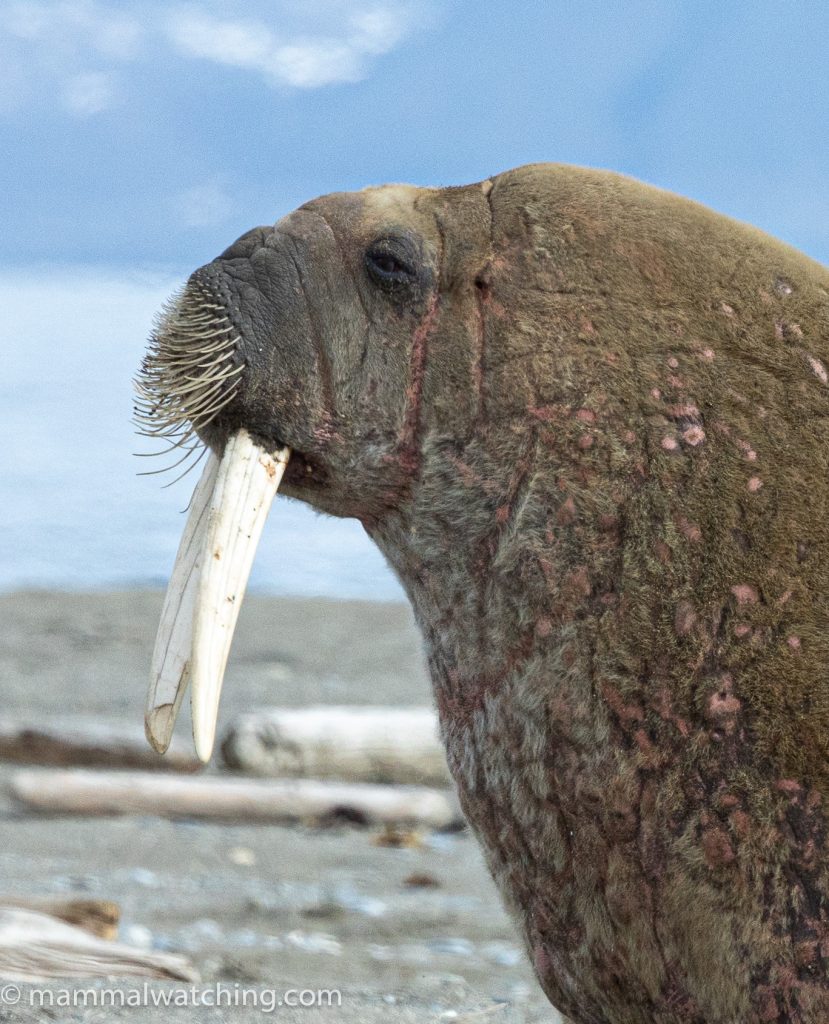
Walrus (Odobenus rosmarus)
Walrus (Odobenus rosmarus)
One of the highlights of any trip to Svalbard, we saw Walruses in Longyearbyen on our first day: four were hauled out on the beach next to the Coal Pier, though we were told this was unusual. We saw a few more over the course of the week, and spent an hour at a well-known haul out north of Longyearbyen at Poolepynten.
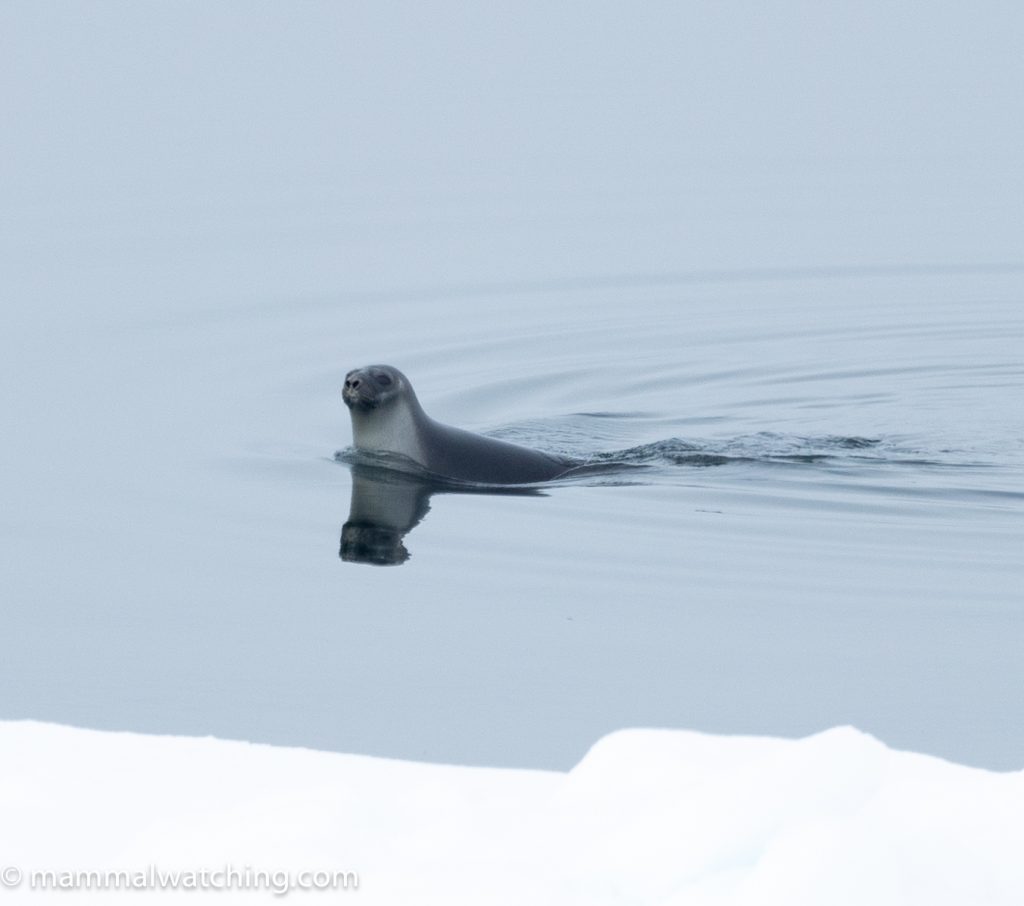
Juvenile ‘Blueback’ Hooded Seal (Cystophora cristata)
Hooded Seal (Cystophora cristata)
One of my key targets for the trip. I suspect we saw more of these than we recorded and that they are as common in the pack ice as the other species. Indeed, we only realised the animals in the photos above and below were Hooded Seals after we looked at the photographs properly. Identification was often difficult because most of the seals we saw were distant. Identification was not helped by the ship’s guides confidently misidentifying animals as Bearded or Ringed Seals.

Hooded Seal (Cystophora cristata), photo Jonas Livet
Of course I wanted to see a male, with his big red balloon, so missing that was a disappointment, though some of the WildWings group spotted one through the scope in open water. If we had spent the full three days in the ice I suspect we would have seen more.
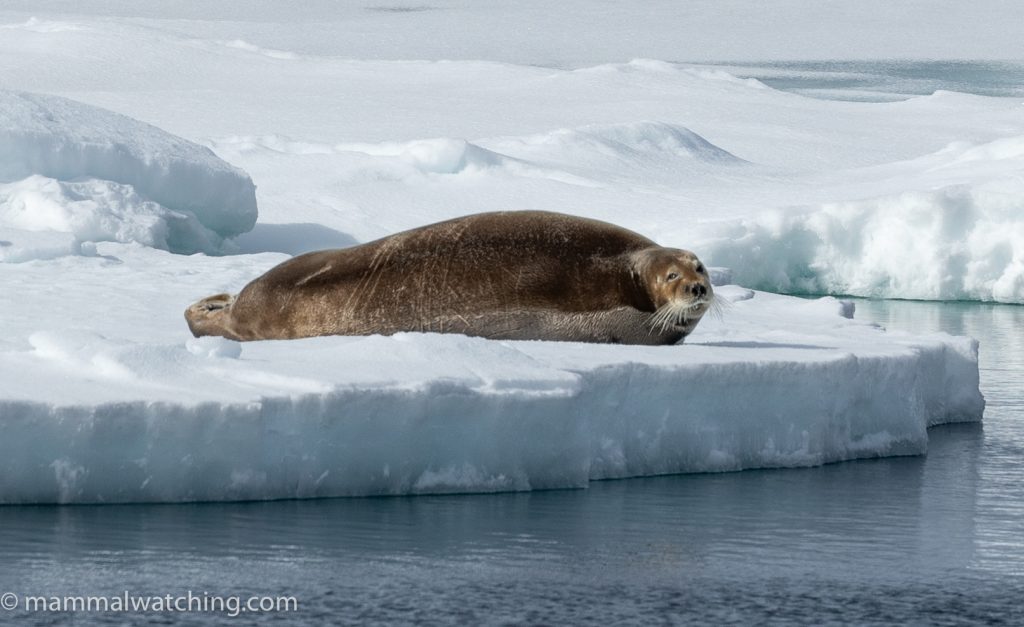
Bearded Seal (Erignathus barbatus)
Bearded Seal (Erignathus barbatus)
A few in the pack ice.
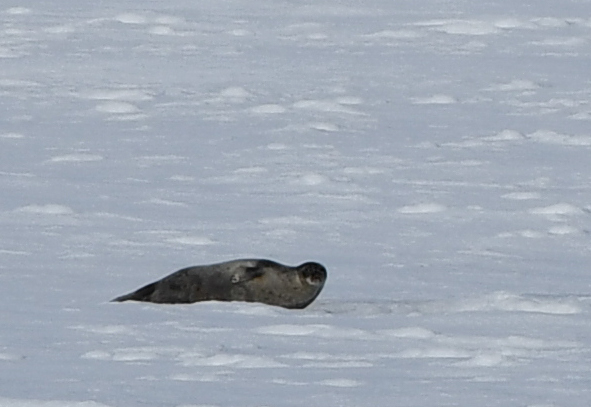
Harp Seal (Pagophilus groenlandicus), photo Jonas Livet
Harp Seal (Pagophilus groenlandicus)
Harp Seals were another key target for me. And – just as with the Hooded Seals – I suspect we saw more than we recorded as many seals were so distant that they were difficult to identify. Others were misidentified as Ringed or Bearded Seals by the ship’s guides. My first confirmed sighting was a raft of 20 or 30 animals clustered closely together as we were leaving the pack ice on day 4: the fact that so many seals were together made us pay attention. We saw at least one other animal quite well out on the ice.
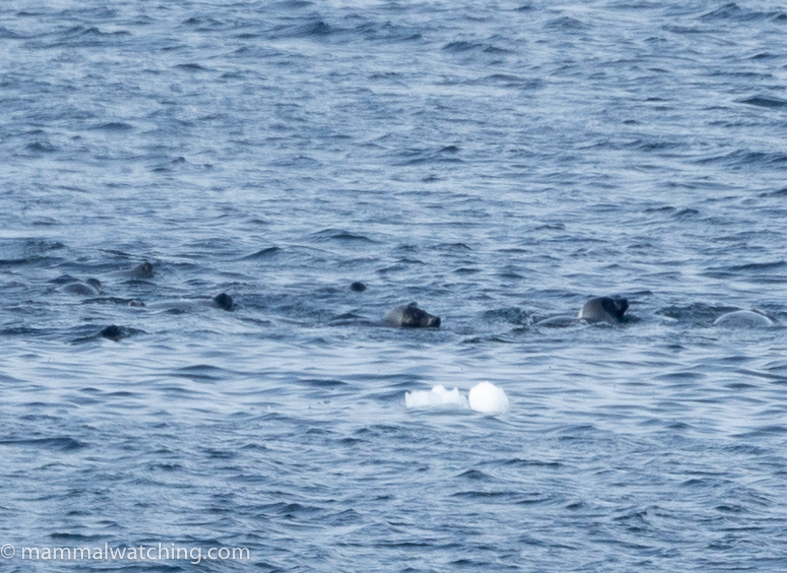
Harp Seals (Pagophilus groenlandicus)
Jonathan Ben Simon’s trip in 2022 came across a colony of several thousand Harp Seals on the ice which must have been impressive.
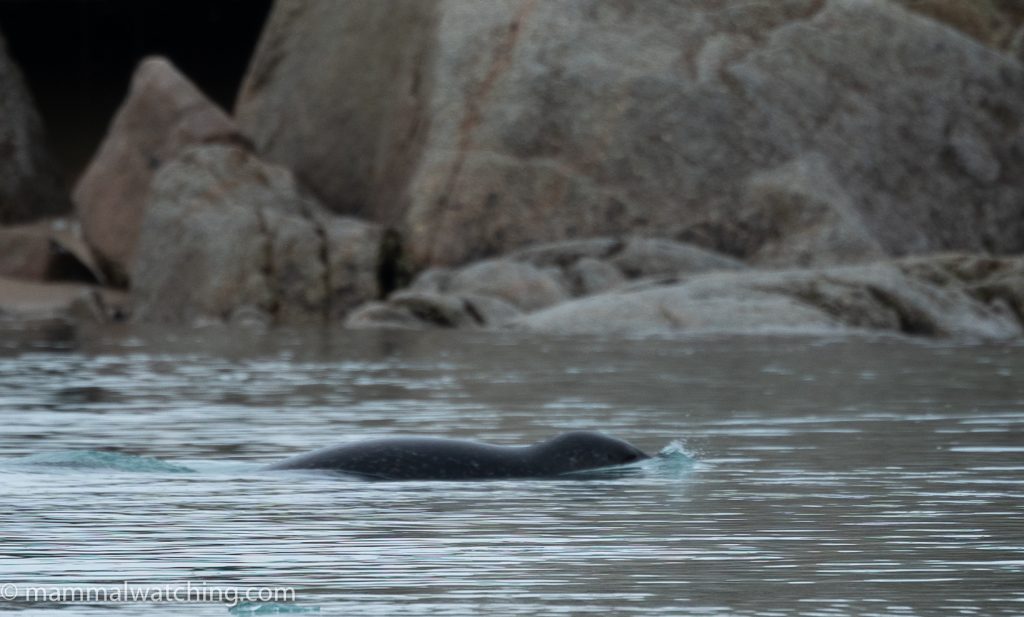
Harbor Seal (Phoca vitulina)
Harbor Seal (Phoca vitulina)
We saw a couple of Harbour Seals very close to shore in fjords in central Spitsbergen. They are seldom seen offshore or in the ice I believe.
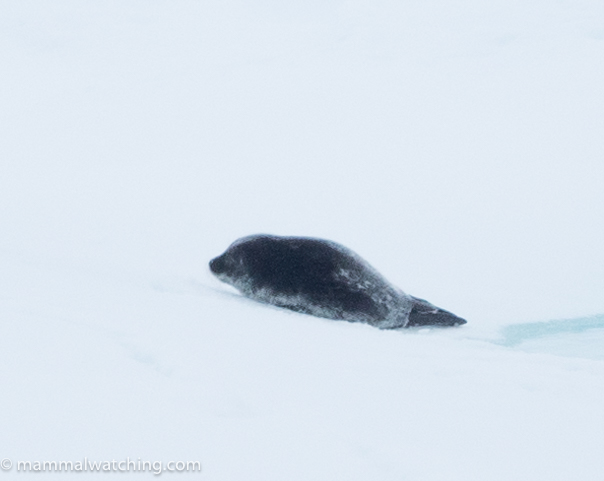
Ringed Seal (Pusa hispida)
Ringed Seal (Pusa hispida)
We saw several in the pack ice but they were generally shy and seen only from a distance.
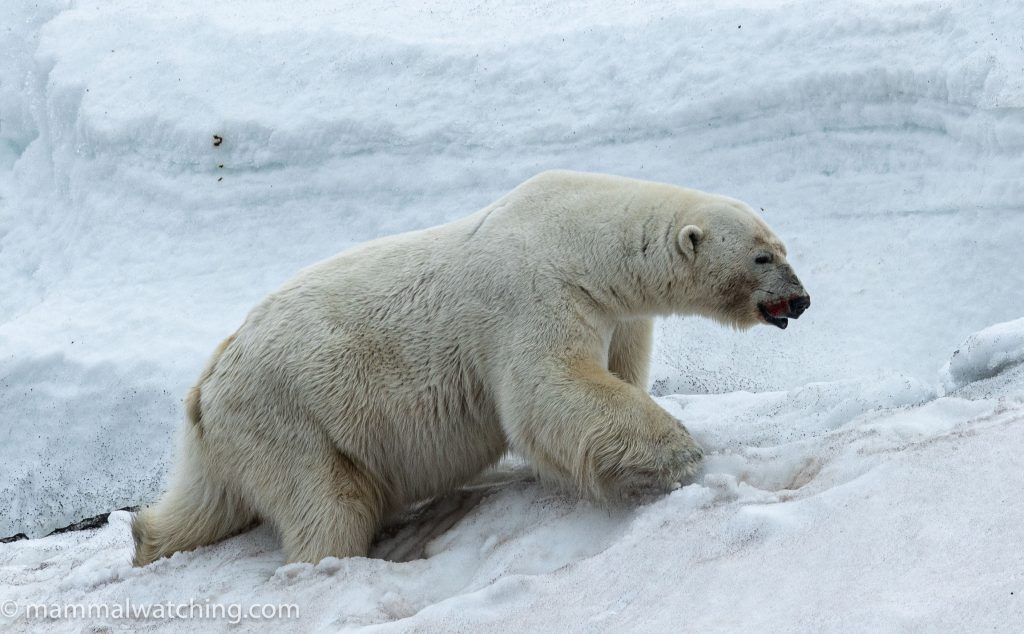
Polar Bear (Ursus maritimus)
Polar Bear (Ursus maritimus)
If there is one animal that the ship will make an effort to find then it is this one. Every passenger wants to see a bear! Laurence, one of the guides spotted an animal on the shore at 5.30am on our second morning. After distant scope views, and breakfast, we took the zodiacs over for a closer look. As we were driving over there a second bear arrived and we had fabulous views of the two animals feeding on a cetacean carcass, one of at least three animals in the same place in various stages of decomposition. We identified the carcass as a White-beaked Dolphin after looking at photos of the skull and teeth.
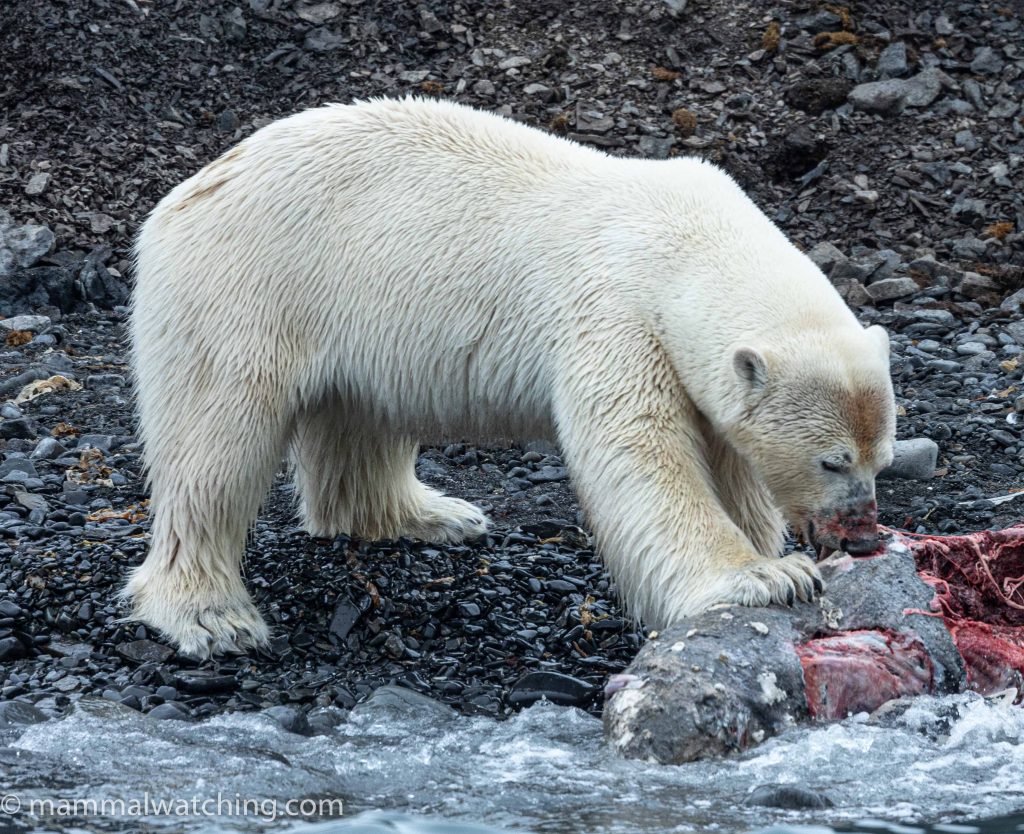
Polar Bear (Ursus maritimus)
This collection of dead dolphins was a mystery: why would several dolphin carcasses die at different times and end up in the same place? When I posted the pictures on Facebook I was told (thank you Morten Jørgensen) that the two bears were not, as the guides had thought, a mother and sub-adult: the larger animal was a male, and probably the other animal too. Moreover, Morten understood that several dolphins had died here after being trapped in the ice. The carcasses were the same age and the different rates of decomposition due to how much had been eaten from each.
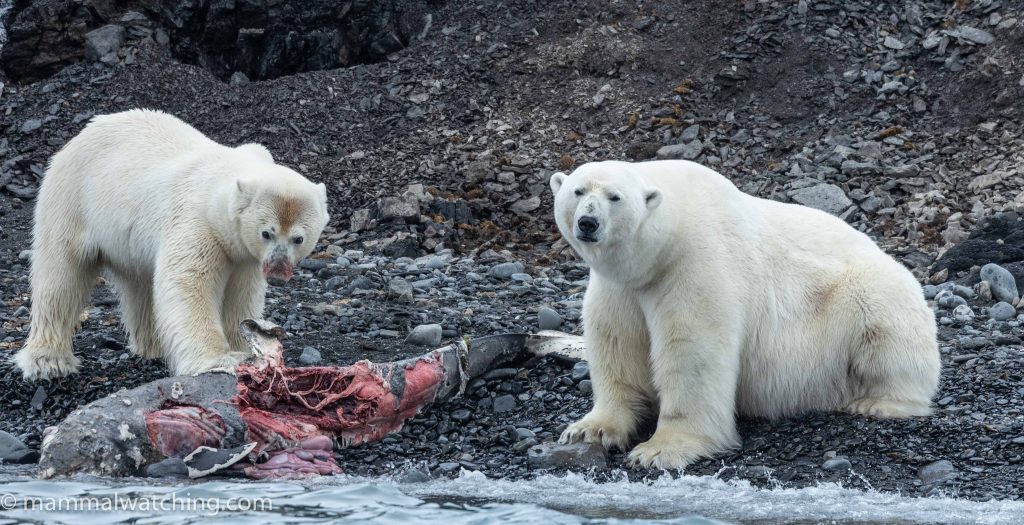
Polar Bear (Ursus maritimus)
We saw two – separate – bears out on the ice, though distantly.
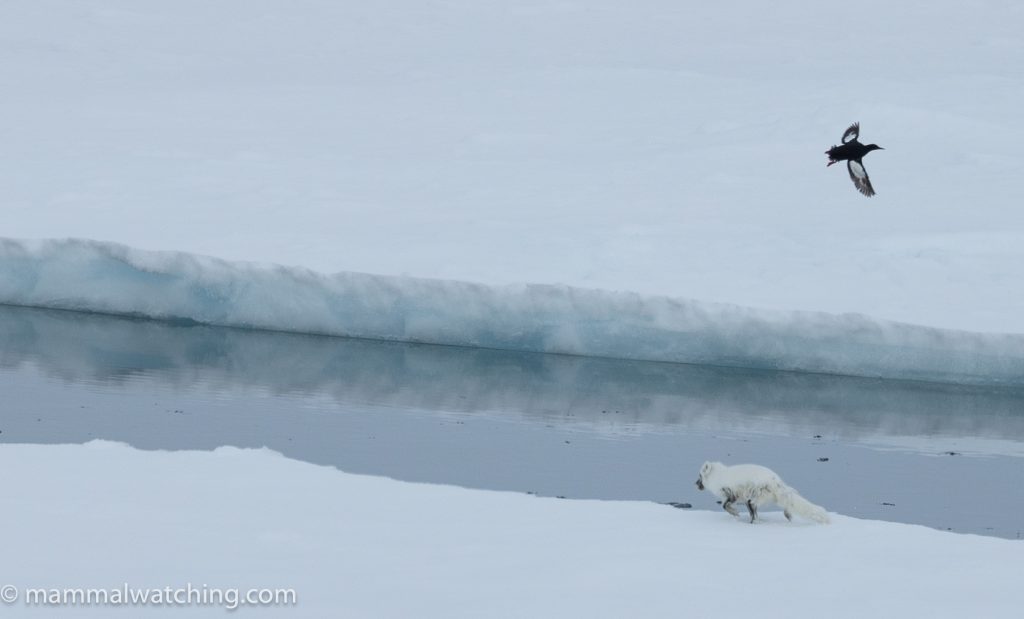
Arctic Fox (Vulpes lagopus)
Arctic Fox (Vulpes lagopus)
Some of the group saw several foxes during an evening tour out of Longyearbyen. One or two animals were seen during shore excursions. This fox was drifting on a large slab of ice about 40 miles offshore, and half-heartedly chasing sea birdss. I hope the ice connected- or will connect – in ways that will allow the animal to get back to the mainland.
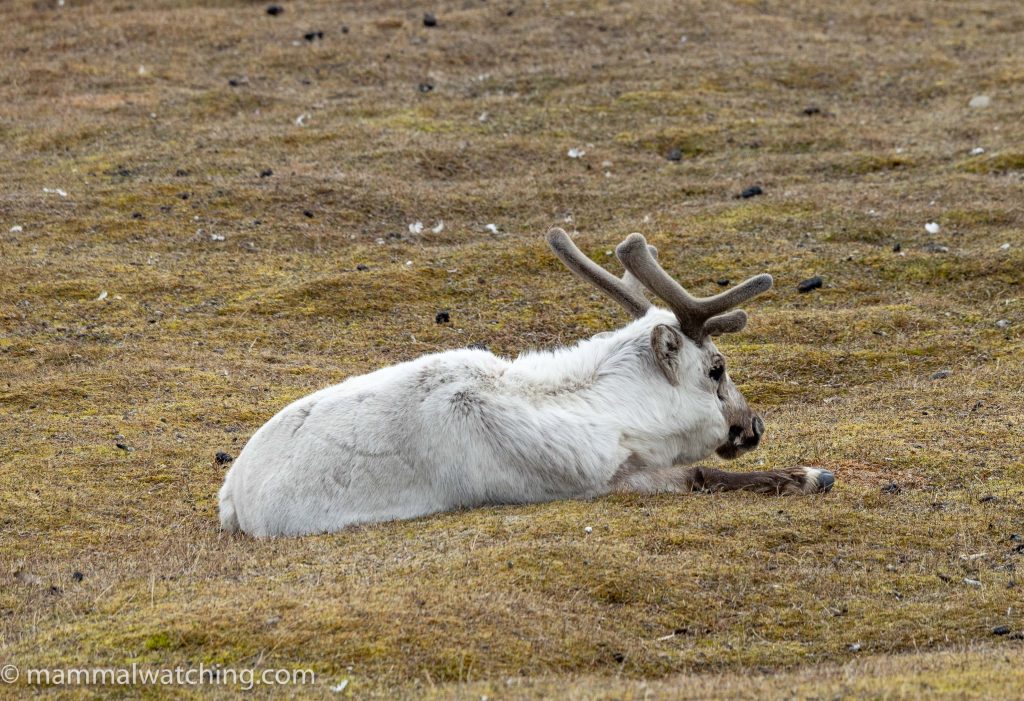
Svalbard Reindeer (Rangifer tarandus platyrhynchus)
Reindeer (Caribou) (Rangifer tarandus platyrhynchus)
This small subspecies of Reindeer is very common around Longyearbyen and you should see one within five minutes. They were seen often during the rest of the trip though out of Longyearbyen then tend to be shy because they are widely hunted.
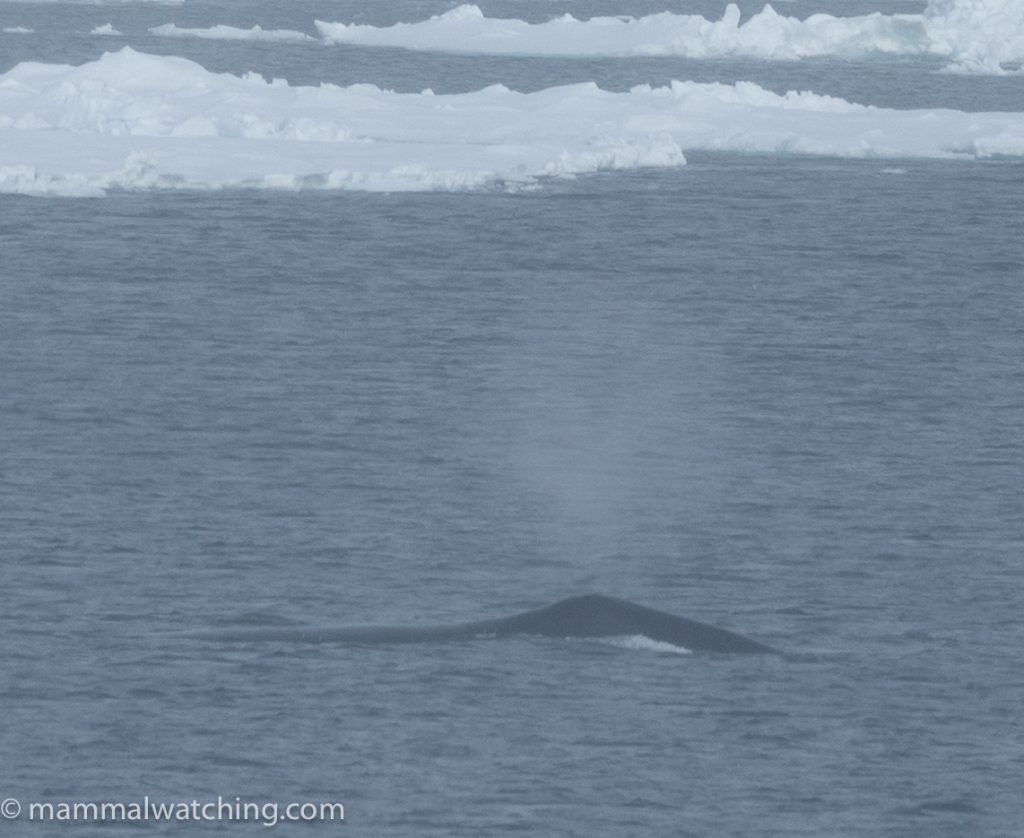
Bowhead Whale (Balaena mysticetus)
Bowhead Whale (Balaena mysticetus)
My number one target for the trip. We saw four animals, two on each of the days we spent in the pack ice. A guide spotted the first animal and though I saw it once we lost it. A few hours later Chrissie spotted the animal above and we had a lengthy – though distant – view of the whale swimming through leads (channels) in the ice. Wonderful.
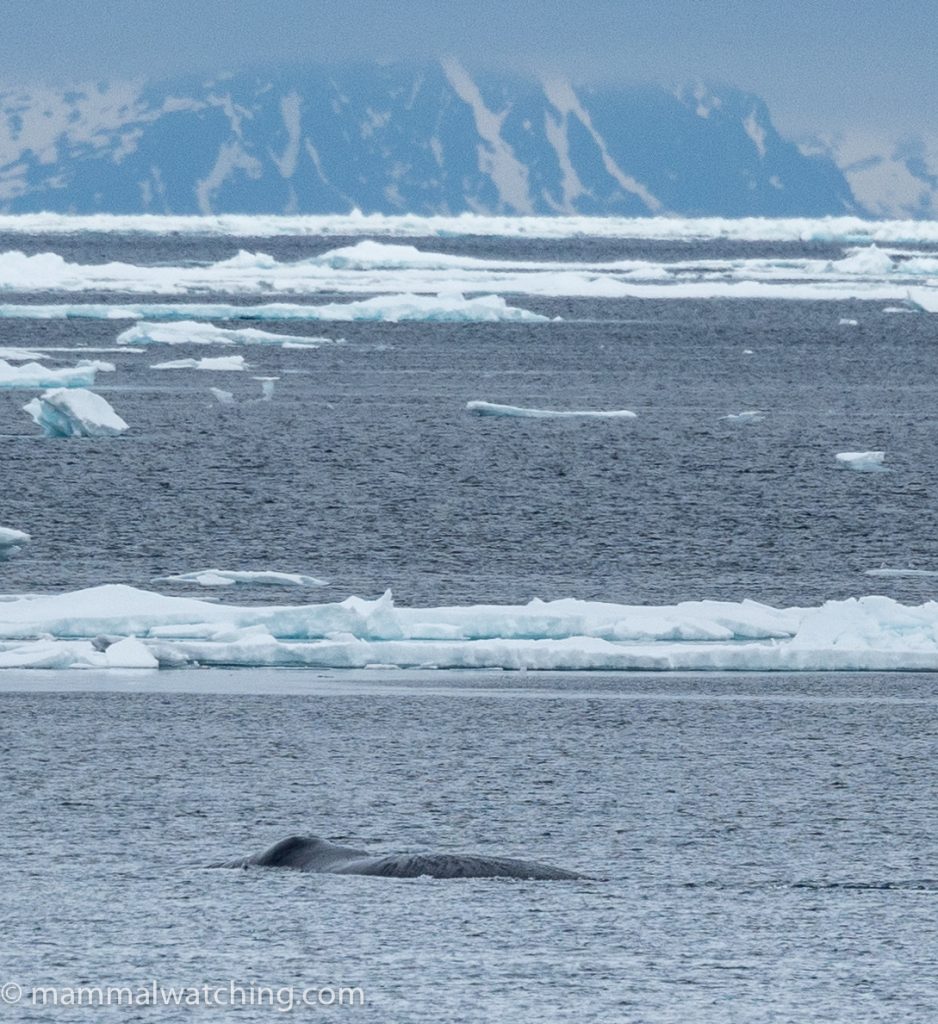
Bowhead Whale (Balaena mysticetus)
When we returned to the ice on day 6 I spotted the animal above, which was accompanied by a calf. The animals were surface feeding and not barely any of their body. So much so that at one stage I thought they might be Narwhals. Another lengthy and slightly less distant sighting. The calf did some pec slapping, though once again we did not see a tail fluke.
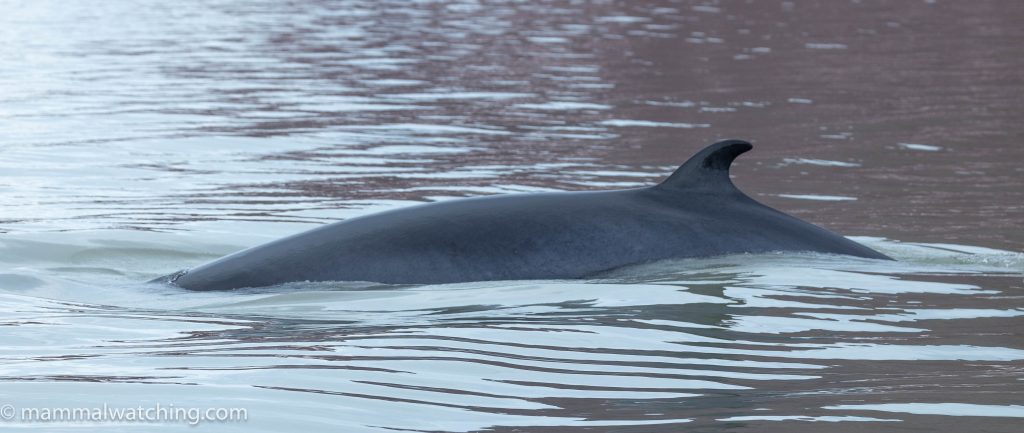
Common Minke Whale (Balaenoptera acutorostrata)
Common Minke Whale (Balaenoptera acutorostrata)
We saw Minkes on several days including one animal that was repeatedly breaching, and a group of four actively feeding around the boat on our last evening.
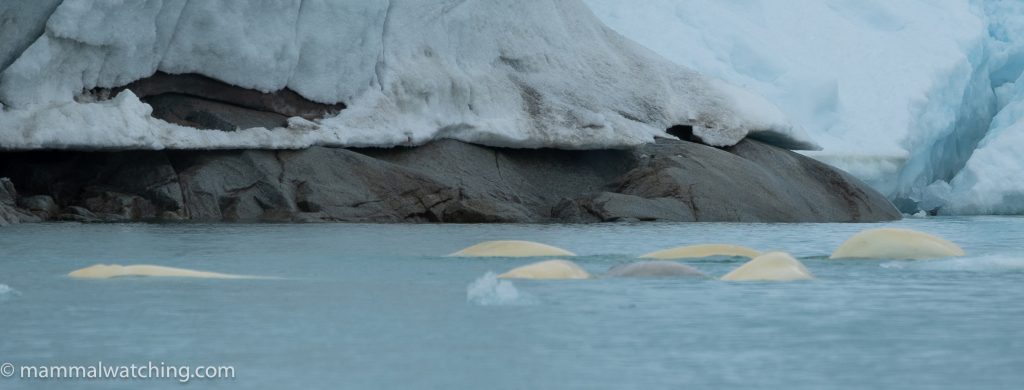
Beluga (Delphinapterus leucas)
Beluga (Delphinapterus leucas)
Belugas seem to be one of the more difficult Arctic species to spot around Svalbard. We saw a pod of 10+ animals feeding at the mouth of a glacier (a favourite habitat for Beluga) at Smeerenburgfjorden.
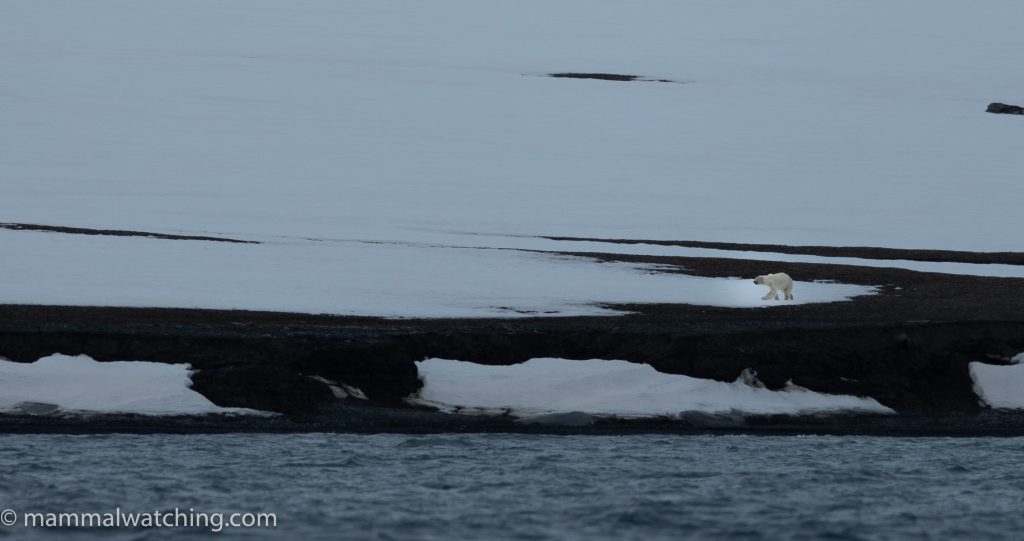
Distant Polar Bear (Ursus maritimus)
Stuff we Missed
I saw my three main targets: Bowhead Whales, Hooded and Harp Seals, which were my three most wanted European mammals missing from my list. I was disappointed not to see a thousand-strong Harp Seal haul out on the ice, nor see a male Hooded Seal in all his splendour. But still, mission successful.
I had imagined we would see White-beaked Dolphins, and though Chrissie spotted a couple of dorsal fins that were likely this species I am not aware of anyone on the ship seeing them well. We might have expected to have seen Fin and possibly Humpback Whales, with a small chance for Northern Bottlenose Whale and a tiny chance for Narwhal (a truly tiny chance: I don’t think any of the guides on the ship had ever seen a Narwhal).
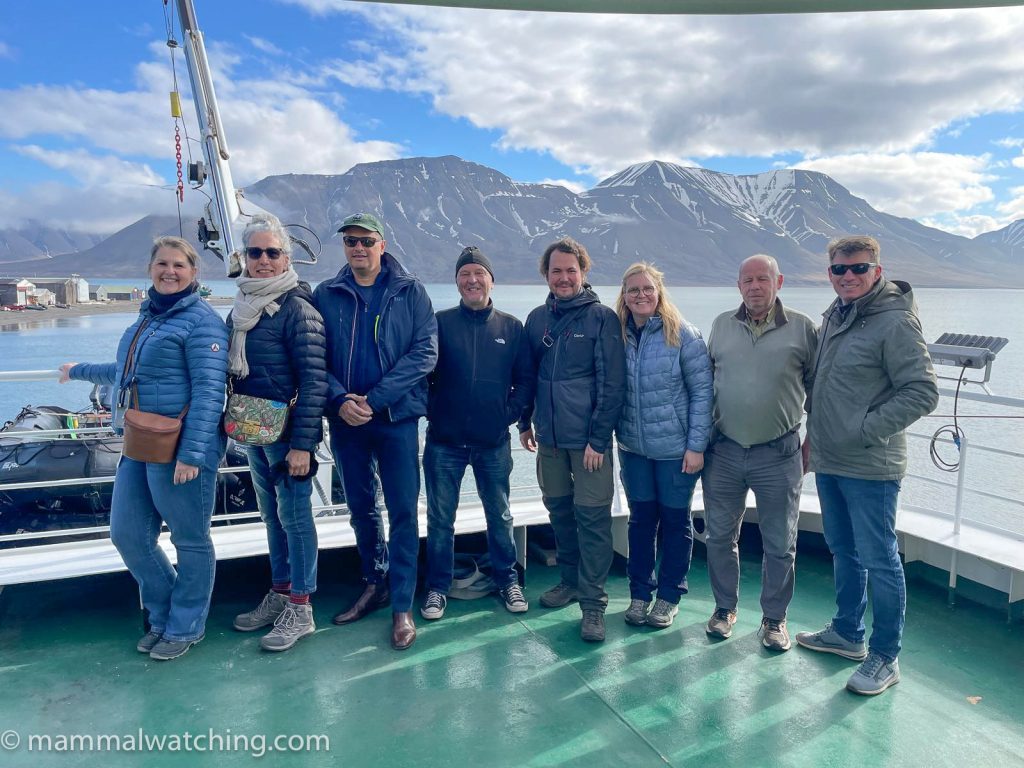
Final Thoughts & Thanks
This was an enjoyable and pretty successful trip, despite the boat taking the wrong route. It would have been more enjoyable and likely more successful if had we spent the full amount of time allotted in the ice. If we had I’m confident we would have better looks at the Bowheads, Harp and Hooded Seals. The ice to the northwest of Svalbard does seem like to be a reliable area for those three species, and so I hope Oceanwide will run this trip again and I look forward to reading what they find, especially if they follow the correct itinerary!
Many thanks to Todd Pusser for reassuring me about my Hooded Seal identification (though any mistakes are my responsibility), and to Chris Collins and his WildWings group for sharing information on board the Hondius and for being on the ball about the itinerary we were meant to be taking and taking it up with the crew.
Though an organised cruise might not be to every mammalwatcher’s liking, I think they are are a lot more fun if you travel with a group of mammalwatchers. More people to spot things, more people to enjoy the bar with, and if your group can fill a zodiac you have more control over your day’s itinerary. A very big thanks to my fellow mammalwatchers for making the trip so successful and so much fun. Next stop Antarctica. Who is coming?
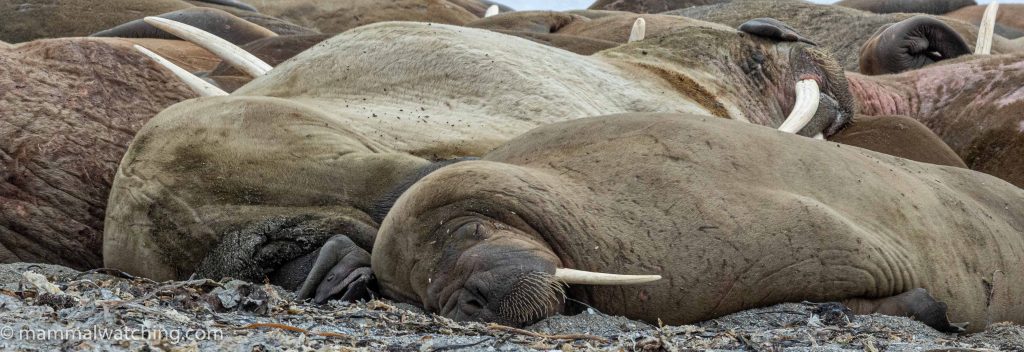
Walrus (Odobenus rosmarus)
Post author
17 Comments
-
-
JanEbr
Are the walruses common in town in summer? Our friends who used to live there spoke about walruses as something unusual, but maybe they just weren’t looking?
You are not forbidden from walking around town, you are just required to have a gun – this can be rented in town, but requires some advance paperwork (or at least it was like this in 2015 and a long time before that).
Care to share how much this “affordable” way to get to the ice costs? 🙂
-
-
vmoser
Actually, we saw quite a few Walrus from town(trip report coming soon). Walrus in Longyearbyen has been regular for a few years, but at least the beach haulout in the harbour is not always there. We did see some more Walrus randomly in the water around town (scanning with the scope) or during the cruises from the town (quite a few)
-
-
JeffHigdon
Ita shame that the guides were confidently misidentifying the phocids. My number one rule when guiding wildlife tours is to be honest about my level of certainty, and I will tell you I don’t know or I’m not sure if that’s the case.
Glad you got your bowhead! But I still say the Foxe Basin floe edge in late June is the best place on the planet for bowhead encounters 🙂
-
Ian Thompson
Tracey and I are planning to go on next year’s version of this trip, from June 10 to 17, 2025. It would be great if other mammal enthusiasts were also on the cruise to help spot wildlife and encourage mammal-centric zodiac activities. Please email me at ibtson@yahoo.com if you are considering joining so that I can help convince you 😊.
Leave a Reply
You must be logged in to post a comment.


Sebastian Kennerknecht
You are saying so much with so few words, haha. I’m with you on cruise ships but glad you made the best of it!